Click Chemistry as an Efficient Toolbox for Coupling Sterically Hindered Molecular Systems to Obtain Advanced Materials for Nanomedicine
Abstract
1. Introduction
2. Click Reactions for Functionalization of Polymeric Systems
2.1. Polymer–Biofunctionality Conjugates: Complexity in Scope and Size
2.1.1. Polymer–Drug Conjugates
2.1.2. Polymer and Peptides/Proteins
2.1.3. Polymer–Nucleic Acid Conjugates
2.1.4. Polymer–Aptamer Conjugates
3. Functionalization of Cyclodextrins
3.1. CD Functionalization/Conjugation with Dendritic Structures
3.2. CD-Based Nanosponges and Hydrogels
3.3. Star and Miktoarm CDs
3.4. CD–Biomacromolecule Conjugates
4. Functionalization of Fullerenes
4.1. Mono-Adducts of Fullerene
4.1.1. Identical Addends (A)
4.1.2. Different Addends (B)
5. Conclusions and Final Remarks
Author Contributions
Funding
Conflicts of Interest
References
- Kolb, H.C.; Finn, M.G.; Sharpless, K.B. Click Chemistry: Diverse Chemical Function from a Few Good Reactions. Angew. Chem. Int. Ed. Engl. 2001, 40, 2004–2021. [Google Scholar] [CrossRef] [PubMed]
- Moses, J.E.; Moorhouse, A.D. The Growing Applications of Click Chemistry. Chem. Soc. Rev. 2007, 36, 1249–1262. [Google Scholar] [CrossRef] [PubMed]
- Huisgen, R.; Szeimies, G.; Möbius, L. 1.3-Dipolare Cycloadditionen, XXXII. Kinetik Der Additionen Organischer Azide an CC-Mehrfachbindungen. Chem. Ber. 1967, 100, 2494–2507. [Google Scholar] [CrossRef]
- Rostovtsev, V.V.; Green, L.G.; Fokin, V.V.; Sharpless, K.B. A Stepwise Huisgen Cycloaddition Process: Copper(I)-Catalyzed Regioselective “Ligation” of Azides and Terminal Alkynes. Angew. Chem. Int. Ed. 2002, 41, 2596–2599. [Google Scholar] [CrossRef]
- Tornøe, C.W.; Christensen, C.; Meldal, M. Peptidotriazoles on Solid Phase: [1,2,3]-Triazoles by Regiospecific Copper(I)-Catalyzed 1,3-Dipolar Cycloadditions of Terminal Alkynes to Azides. J. Org. Chem. 2002, 67, 3057–3064. [Google Scholar] [CrossRef]
- Kazybayeva, D.S.; Irmukhametova, G.S.; Khutoryanskiy, V.V. Thiol-Ene “Click Reactions” as a Promising Approach to Polymer Materials. Polym. Sci. Ser. B 2022, 64, 1–16. [Google Scholar] [CrossRef]
- Oliveira, B.L.; Guo, Z.; Bernardes, G.J.L. Inverse Electron Demand Diels–Alder Reactions in Chemical Biology. Chem. Soc. Rev. 2017, 46, 4895–4950. [Google Scholar] [CrossRef]
- Hong, V.; Steinmetz, N.F.; Manchester, M.; Finn, M.G. Labeling Live Cells by Copper-Catalyzed Alkyne−Azide Click Chemistry. Bioconjug Chem. 2010, 21, 1912–1916. [Google Scholar] [CrossRef]
- Geng, Z.; Shin, J.J.; Xi, Y.; Hawker, C.J. Click Chemistry Strategies for the Accelerated Synthesis of Functional Macromolecules. J. Polym. Sci. 2021, 59, 963–1042. [Google Scholar] [CrossRef]
- Luu, T.; Gristwood, K.; Knight, J.C.; Jörg, M. Click Chemistry: Reaction Rates and Their Suitability for Biomedical Applications. Bioconjug Chem. 2024, 35, 715–731. [Google Scholar] [CrossRef]
- Hu, J.; Peng, K.; Guo, J.; Shan, D.; Kim, G.B.; Li, Q.; Gerhard, E.; Zhu, L.; Tu, W.; Lv, W.; et al. Click Cross-Linking-Improved Waterborne Polymers for Environment-Friendly Coatings and Adhesives. ACS Appl. Mater. Interfaces 2016, 8, 17499–17510. [Google Scholar] [CrossRef] [PubMed]
- Liu, F.; Sun, Y.; Gu, J.; Gao, Q.; Sun, D.; Zhang, X.; Pan, B.; Qian, J. Highly Efficient Photodegradation of Various Organic Pollutants in Water: Rational Structural Design of Photocatalyst via Thiol-Ene Click Reaction. Chem. Eng. J. 2020, 381, 122631. [Google Scholar] [CrossRef]
- Sha, J.; Sun, Y.; Yu, H.; Yang, Z.; Chu, H.; Wang, Y.; Yue, Q.; Yin, W.; Xu, S. Comparison of Nano-TiO2 Immobilization Approaches onto Biochar: Superiorities of Click Chemistry Strategy and Self-Acceleration of Pollutant Degradation. J. Environ. Chem. Eng. 2022, 10, 107544. [Google Scholar] [CrossRef]
- Yang, W.; Chen, J.; Yan, J.; Liu, S.; Yan, Y.; Zhang, Q. Advance of Click Chemistry in Anion Exchange Membranes for Energy Application. J. Polym. Sci. 2022, 60, 627–649. [Google Scholar] [CrossRef]
- Zhang, R.; Li, J.; Xu, Z.; Jerrams, S.; Hu, S.; Liu, L.; Wen, S.; Zhang, L. Achieving Strong Chemical Interface and Superior Energy-Saving Capability at the Crosslinks of Rubber Composites Containing Graphene Oxide Using Thiol-Vinyl Click Chemistry. Compos. Sci. Technol. 2023, 233, 109907. [Google Scholar] [CrossRef]
- Liu, X.; Astudillo Potes, M.D.; Serdiuk, V.; Dashtdar, B.; Schreiber, A.C.; Rezaei, A.; Miller, A.L.; Hamouda, A.M.; Shafi, M.; Elder, B.D.; et al. Bioactive Moldable Click Chemistry Polymer Cement with Nano-Hydroxyapatite and Growth Factor-Enhanced Posterolateral Spinal Fusion in a Rabbit Model. ACS Appl. Bio Mater. 2024, 7, 2450–2459. [Google Scholar] [CrossRef] [PubMed]
- Li, F.; Chen, X.; He, Y.; Peng, Z. Mucoadhesive Thiolated Hyaluronic Acid/Pluronic F127 Nanogel Formation via Thiol–Maleimide Click Reaction for Intravesical Drug Delivery. ACS Appl. Bio Mater. 2024, 7, 1976–1989. [Google Scholar] [CrossRef]
- Zhao, G.; Ge, T.; Yan, Y.; Shuai, Q.; Su, W.-K. Highly Efficient Modular Construction of Functional Drug Delivery Platform Based on Amphiphilic Biodegradable Polymers via Click Chemistry. Int. J. Mol. Sci. 2021, 22, 10407. [Google Scholar] [CrossRef]
- Amorim, A.C.; Burke, A.J. What Is the Future of Click Chemistry in Drug Discovery and Development? Expert. Opin. Drug Discov. 2024, 19, 267–280. [Google Scholar] [CrossRef]
- Kaur, J.; Saxena, M.; Rishi, N. An Overview of Recent Advances in Biomedical Applications of Click Chemistry. Bioconjug Chem. 2021, 32, 1455–1471. [Google Scholar] [CrossRef]
- Lima, A.L.; Gratieri, T.; Cunha-Filho, M.; Gelfuso, G.M. Polymeric Nanocapsules: A Review on Design and Production Methods for Pharmaceutical Purpose. Methods 2022, 199, 54–66. [Google Scholar] [CrossRef] [PubMed]
- Hasannia, M.; Aliabadi, A.; Abnous, K.; Taghdisi, S.M.; Ramezani, M.; Alibolandi, M. Synthesis of Block Copolymers Used in Polymersome Fabrication: Application in Drug Delivery. J. Control. Release 2022, 341, 95–117. [Google Scholar] [CrossRef] [PubMed]
- Wang, C.; He, W.; Wang, F.; Yong, H.; Bo, T.; Yao, D.; Zhao, Y.; Pan, C.; Cao, Q.; Zhang, S.; et al. Recent Progress of Non-Linear Topological Structure Polymers: Synthesis, and Gene Delivery. J. Nanobiotechnol. 2024, 22, 40. [Google Scholar] [CrossRef]
- Hebels, E.R.; Bindt, F.; Walther, J.; van Geijn, M.; Weterings, J.; Hu, Q.; Colombo, C.; Liskamp, R.; Rijcken, C.; Hennink, W.E.; et al. Orthogonal Covalent Entrapment of Cargo into Biodegradable Polymeric Micelles via Native Chemical Ligation. Biomacromolecules 2023, 24, 4385–4396. [Google Scholar] [CrossRef] [PubMed]
- Yoon, H.Y.; Lee, D.; Lim, D.; Koo, H.; Kim, K. Copper-Free Click Chemistry: Applications in Drug Delivery, Cell Tracking, and Tissue Engineering. Adv. Mater. 2022, 34, 2107192. [Google Scholar] [CrossRef]
- Degirmenci, A.; Sanyal, R.; Sanyal, A. Metal-Free Click-Chemistry: A Powerful Tool for Fabricating Hydrogels for Biomedical Applications. Bioconjug Chem. 2024, 35, 433–452. [Google Scholar] [CrossRef]
- Ding, H.; Li, B.; Jiang, Y.; Liu, G.; Pu, S.; Feng, Y.; Jia, D.; Zhou, Y. PH-Responsive UV Crosslinkable Chitosan Hydrogel via “Thiol-Ene” Click Chemistry for Active Modulating Opposite Drug Release Behaviors. Carbohydr. Polym. 2021, 251, 117101. [Google Scholar] [CrossRef]
- Schwarz, W.H.E.; Schmidbaur, H. Observations and Descriptions versus Explanations—An Example: Does Nature, Does Theory Know About Steric Hindrance? Chem. A Eur. J. 2012, 18, 4470–4479. [Google Scholar] [CrossRef]
- Hassan, M.; Bhat, G.A.; Darensbourg, D.J. Post-Polymerization Functionalization of Aliphatic Polycarbonates Using Click Chemistry. Polym. Chem. 2024, 15, 1803–1820. [Google Scholar] [CrossRef]
- Kubo, T.; Easterling, C.P.; Olson, R.A.; Sumerlin, B.S. Synthesis of Multifunctional Homopolymers via Sequential Post-Polymerization Reactions. Polym. Chem. 2018, 9, 4605–4610. [Google Scholar] [CrossRef]
- Akar, E.; Luleburgaz, S.; Gunay, U.S.; Kumbaraci, V.; Tunca, U.; Durmaz, H. Amino-Yne Reaction: An Exquisite Method for Polymer-Polymer Conjugation and Post-Polymerization Modification. Eur. Polym. J. 2023, 199, 112470. [Google Scholar] [CrossRef]
- Li, Y.; Chang, R.; Chen, Y. Recent Advances in Post-polymerization Modifications on Polypeptides: Synthesis and Applications. Chem. Asian J. 2022, 17, e2022003182022. [Google Scholar] [CrossRef] [PubMed]
- Hema, K.; Sureshan, K.M. Topochemical Azide–Alkyne Cycloaddition Reaction. Acc. Chem. Res. 2019, 52, 3149–3163. [Google Scholar] [CrossRef] [PubMed]
- Binder, W.H.; Sachsenhofer, R. ‘Click’ Chemistry in Polymer and Materials Science. Macromol. Rapid Commun. 2007, 28, 15–54. [Google Scholar] [CrossRef]
- Fındık, V.; Degirmenci, I.; Çatak, Ş.; Aviyente, V. Theoretical Investigation of Thiol-Ene Click Reactions: A DFT Perspective. Eur. Polym. J. 2019, 110, 211–220. [Google Scholar] [CrossRef]
- Ganesh, V.; Sudhir, V.S.; Kundu, T.; Chandrasekaran, S. 10 Years of Click Chemistry: Synthesis and Applications of Ferrocene-Derived Triazoles. Chem. Asian J. 2011, 6, 2670–2694. [Google Scholar] [CrossRef]
- Liao, J.; Peng, H.; Wei, X.; Song, Y.; Liu, C.; Li, D.; Yin, Y.; Xiong, X.; Zheng, H.; Wang, Q. A Bio-Responsive 6-Mercaptopurine/Doxorubicin Based “Click Chemistry” Polymeric Prodrug for Cancer Therapy. Mater. Sci. Eng. C 2020, 108, 110461. [Google Scholar] [CrossRef]
- Nguyen, A.; Chao, P.-H.; Ong, C.Y.; Rouhollahi, E.; Fayez, N.A.L.; Lin, L.; Brown, J.I.; Böttger, R.; Page, B.; Wong, H.; et al. Chemically Engineering the Drug Release Rate of a PEG-Paclitaxel Conjugate Using Click and Steric Hindrance Chemistries for Optimal Efficacy. Biomaterials 2022, 289, 121735. [Google Scholar] [CrossRef]
- Xu, J.; Lin, S.; Hu, H.; Xing, Q.; Geng, J. Tumor-Targeting Polymer–Drug Conjugate for Liver Cancer Treatment In Vitro. Polymers 2022, 14, 4515. [Google Scholar] [CrossRef]
- Zhou, R.; Zhang, M.; He, J.; Liu, J.; Sun, X.; Ni, P. Functional CRGD-Conjugated Polymer Prodrug for Targeted Drug Delivery to Liver Cancer Cells. ACS Omega 2022, 7, 21325–21336. [Google Scholar] [CrossRef]
- Sun, H.; Yan, L.; Chang, M.Y.Z.; Carter, K.A.; Zhang, R.; Slyker, L.; Lovell, J.F.; Wu, Y.; Cheng, C. A Multifunctional Biodegradable Brush Polymer-Drug Conjugate for Paclitaxel/Gemcitabine Co-Delivery and Tumor Imaging. Nanoscale Adv. 2019, 1, 2761–2771. [Google Scholar] [CrossRef] [PubMed]
- Osuofa, J.; Husson, S.M. Preparation of Protein A Membranes Using Propargyl Methacrylate-Based Copolymers and Copper-Catalyzed Alkyne–Azide Click Chemistry. Polymers 2024, 16, 239. [Google Scholar] [CrossRef] [PubMed]
- Wu, K.B.; Skrodzki, C.J.A.; Su, Q.; Lin, J.; Niu, J. “Click Handle”-Modified 2′-Deoxy-2′-Fluoroarabino Nucleic Acid as a Synthetic Genetic Polymer Capable of Post-Polymerization Functionalization. Chem. Sci. 2022, 13, 6873–6881. [Google Scholar] [CrossRef]
- Bakardzhiev, P.; Toncheva-Moncheva, N.; Mladenova, K.; Petrova, S.; Videv, P.; Moskova-Doumanova, V.; Topouzova-Hristova, T.; Doumanov, J.; Rangelov, S. Assembly of Amphiphilic Nucleic Acid-Polymer Conjugates into Complex Superaggregates: Preparation, Properties, and in Vitro Performance. Eur. Polym. J. 2020, 131, 109692. [Google Scholar] [CrossRef]
- Saxer, S.; Erdogan, O.; Paniagua, C.; Chavanieu, A.; Garric, X.; Darcos, V. Protein-Polymer Bioconjugates Prepared by Post-Polymerization Modification of Alternating Copolymers. Eur. J. Org. Chem. 2022, 2022, e202100576. [Google Scholar] [CrossRef]
- Hironaka, K.; Yoshihara, E.; Nabil, A.; Lai, J.J.; Kikuchi, A.; Ebara, M. Conjugation of Antibody with Temperature-Responsive Polymer via in Situ Click Reaction to Enable Biomarker Enrichment for Increased Diagnostic Sensitivity. Biomater. Sci. 2021, 9, 4870–4879. [Google Scholar] [CrossRef]
- Dimitrov, E.; Toncheva-Moncheva, N.; Doumanov, J.A.; Mladenova, K.; Petrova, S.; Pispas, S.; Rangelov, S. Three-Dimensional Nucleic Acid Nanostructures Based on Self-Assembled Polymer-Oligonucleotide Conjugates of Comblike and Coil-Comb Chain Architectures. Biomacromolecules 2023, 24, 2213–2224. [Google Scholar] [CrossRef]
- Ozer, I.; Pitoc, G.A.; Layzer, J.M.; Moreno, A.; Olson, L.B.; Layzer, K.D.; Hucknall, A.M.; Sullenger, B.A.; Chilkoti, A. PEG-Like Brush Polymer Conjugate of RNA Aptamer That Shows Reversible Anticoagulant Activity and Minimal Immune Response. Adv. Mater. 2022, 34, 2107852. [Google Scholar] [CrossRef]
- Fabre, L.; Rousset, C.; Monier, K.; Da Cruz-Boisson, F.; Bouvet, P.; Charreyre, M.-T.; Delair, T.; Fleury, E.; Favier, A. Fluorescent Polymer-AS1411-Aptamer Probe for DSTORM Super-Resolution Imaging of Endogenous Nucleolin. Biomacromolecules 2022, 23, 2302–2314. [Google Scholar] [CrossRef]
- Deng, Z.; Yang, Q.; Peng, Y.; He, J.; Xu, S.; Wang, D.; Peng, T.; Wang, R.; Wang, X.-Q.; Tan, W. Polymeric Engineering of Aptamer–Drug Conjugates for Targeted Cancer Therapy. Bioconjug Chem. 2020, 31, 37–42. [Google Scholar] [CrossRef]
- Sharick, J.T.; Atieh, A.J.; Gooch, K.J.; Leight, J.L. Click Chemistry Functionalization of self-assembling Peptide Hydrogels. J. Biomed. Mater. Res. A 2023, 111, 389–403. [Google Scholar] [CrossRef]
- Cadamuro, F.; Sampaolesi, S.; Bertolini, G.; Roz, L.; Nicotra, F.; Russo, L. Click Chemistry Protocol for 3D Bioprintable Elastin−Hyaluronic Acid Hydrogels. Chem. Nano Mat. 2023, 9, 726–745. [Google Scholar] [CrossRef]
- Paioti, P.H.S.; Lounsbury, K.E.; Romiti, F.; Formica, M.; Bauer, V.; Zandonella, C.; Hackey, M.E.; del Pozo, J.; Hoveyda, A.H. Click Processes Orthogonal to CuAAC and SuFEx Forge Selectively Modifiable Fluorescent Linkers. Nat. Chem. 2024, 16, 426–436. [Google Scholar] [CrossRef] [PubMed]
- Verma, V.S.; Pandey, A.; Jha, A.K.; Badwaik, H.K.R.; Alexander, A. Ajazuddin Polyethylene Glycol–Based Polymer-Drug Conjugates: Novel Design and Synthesis Strategies for Enhanced Therapeutic Efficacy and Targeted Drug Delivery. Appl. Biochem. Biotechnol. 2024, 196, 7325–7361. [Google Scholar] [CrossRef] [PubMed]
- Zhang, Y.S.; Khademhosseini, A. Advances in Engineering Hydrogels. Science 2017, 356, eaaf3627. [Google Scholar] [CrossRef] [PubMed]
- Li, Y.; Wang, X.; Han, Y.; Sun, H.-Y.; Hilborn, J.; Shi, L. Click Chemistry-Based Biopolymeric Hydrogels for Regenerative Medicine. Biomed. Mater. 2021, 16, 022003. [Google Scholar] [CrossRef]
- Li, X.; Xiong, Y. Application of “Click” Chemistry in Biomedical Hydrogels. ACS Omega 2022, 7, 36918–36928. [Google Scholar] [CrossRef]
- Nerantzaki, M.; Loth, C.; Lutz, J.-F. Chemical Conjugation of Nucleic Acid Aptamers and Synthetic Polymers. Polym. Chem. 2021, 12, 3498–3509. [Google Scholar] [CrossRef]
- Perrone, D.; Marchesi, E.; Preti, L.; Navacchia, M.L. Modified Nucleosides, Nucleotides and Nucleic Acids via Click Azide-Alkyne Cycloaddition for Pharmacological Applications. Molecules 2021, 26, 3100. [Google Scholar] [CrossRef]
- Ando, T.; Takamori, Y.; Yokoyama, T.; Yamamoto, M.; Kawakami, T. Directed Evolution of Dibenzocyclooctyne-Reactive Peptide Tags for Protein Labeling. Biochem. Biophys. Res. Commun. 2021, 534, 27–33. [Google Scholar] [CrossRef]
- Vikas, Y.; Sandeep, K.; Braham, D.; Manjusha, C.; Budhwar, V. Cyclodextrin Complexes: An Approach to Improve the Physicochemical Properties of Drugs and Applications of Cyclodextrin Complexes. Asian J. Pharm. 2018, 12, S394–S4092018. [Google Scholar] [CrossRef]
- Crini, G.; Fourmentinn, S.; Lichtfouse, E. Environmental Chemistry for a Sustainable World. In Cyclodextrin Fundamentals, Reactivity and Analysis; Fourmentin, S., Crini, G., Lichtfouse, E., Eds.; Springer International Publishing: Cham, Switzerland, 2018; Volume 16, ISBN 978-3-319-76158-9. [Google Scholar]
- Liu, Z.; Ye, L.; Xi, J.; Wang, J.; Feng, Z. Cyclodextrin Polymers: Structure, Synthesis, and Use as Drug Carriers. Prog. Polym. Sci. 2021, 118, 101408. [Google Scholar] [CrossRef]
- Khan, A.R.; Forgo, P.; Stine, K.J.; D’Souza, V.T. Methods for Selective Modifications of Cyclodextrins. Chem. Rev. 1998, 98, 1977–1996. [Google Scholar] [CrossRef] [PubMed]
- Jin, Z.-Y. Cyclodextrin Chemistry: Preparation and Application; World Scientific/Chemical Industry Press: Beijing, China, 2013; Volume 1, ISBN 978-981-4436-79-3. [Google Scholar]
- Miljković, M. Relative Reactivity of Hydroxyl Groups in Monosaccharides; Springer: New York, NY, USA, 2010. [Google Scholar]
- Faugeras, P.-A.; Boëns, B.; Elchinger, P.-H.; Brouillette, F.; Montplaisir, D.; Zerrouki, R.; Lucas, R. When Cyclodextrins Meet Click Chemistry. Eur. J. Org. Chem. 2012, 2012, 4087–4105. [Google Scholar] [CrossRef]
- Toomari, Y.; Namazi, H.; Akbar, E.A. Synthesis of the Dendritic Type β-Cyclodextrin on Primary Face via Click Reaction Applicable as Drug Nanocarrier. Carbohydr. Polym. 2015, 132, 205–213. [Google Scholar] [CrossRef]
- Toomari, Y.; Namazi, H.; Entezami, A.A. Fabrication of Biodendrimeric β-Cyclodextrin via Click Reaction with Potency of Anticancer Drug Delivery Agent. Int. J. Biol. Macromol. 2015, 79, 883–893. [Google Scholar] [CrossRef]
- Chen, P.-G.; Huang, Z.-H.; Sun, Z.-Y.; Li, Q.-Q.; Chen, Y.-X.; Zhao, Y.-F.; Li, Y.-M. Synthesis of an MUC1 Glycopeptide Dendrimer Based on β-Cyclodextrin by Click Chemistry. Synlett 2017, 28, 1961–1965. [Google Scholar] [CrossRef]
- Sorroza-Martínez, K.; González-Méndez, I.; Martínez-Serrano, R.D.; Solano, J.D.; Ruiu, A.; Illescas, J.; Zhu, X.X.; Rivera, E. Efficient Modification of PAMAM G1 Dendrimer Surface with β-Cyclodextrin Units by CuAAC: Impact on the Water Solubility and Cytotoxicity. RSC Adv. 2020, 10, 25557–25566. [Google Scholar] [CrossRef]
- López-Méndez, L.J.; Cuéllar-Ramírez, E.E.; Cabrera-Quiñones, N.C.; Rojas-Aguirre, Y.; Guadarrama, P. Convergent Click Synthesis of Macromolecular Dendritic β-Cyclodextrin Derivatives as Non-Conventional Drug Carriers: Albendazole as Guest Model. Int. J. Biol. Macromol. 2020, 164, 1704–1714. [Google Scholar] [CrossRef]
- Lo Meo, P.; Lazzara, G.; Liotta, L.; Riela, S.; Noto, R. Cyclodextrin–Calixarene Co-Polymers as a New Class of Nanosponges. Polym. Chem. 2014, 5, 4499–4510. [Google Scholar] [CrossRef]
- Degirmenci, A.; Ipek, H.; Sanyal, R.; Sanyal, A. Cyclodextrin-Containing Redox-Responsive Nanogels: Fabrication of a Modular Targeted Drug Delivery System. Eur. Polym. J. 2022, 181, 111645. [Google Scholar] [CrossRef]
- Wang, Y.; Liu, Y.; Liang, J.; Zou, M. A Cyclodextrin-Core Star Copolymer with Y-Shaped ABC Miktoarms and Its Unimolecular Micelles. RSC Adv. 2017, 7, 11691–11700. [Google Scholar] [CrossRef]
- Gou, P.F.; Zhu, W.P.; Shen, Z.Q. Synthesis, Self-Assembly, and Drug-Loading Capacity of Well-Defined Cyclodextrin-Centered Drug-Conjugated Amphiphilic A14B7 Miktoarm Star Copolymers Based on Poly(ε-Caprolactone) and Poly(Ethylene Glycol). Biomacromolecules 2010, 11, 934–943. [Google Scholar] [CrossRef] [PubMed]
- Li, Y.; Qian, Y.; Liu, T.; Zhang, G.; Hu, J.; Liu, S. Asymmetrically Functionalized β-Cyclodextrin-Based Star Copolymers for Integrated Gene Delivery and Magnetic Resonance Imaging Contrast Enhancement. Polym. Chem. 2014, 5, 1743–1750. [Google Scholar] [CrossRef]
- Rojas-Aguirre, Y.; Torres-Mena, M.A.; López-Méndez, L.J.; Alcaraz-Estrada, S.L.; Guadarrama, P.; Urucha-Ortíz, J.M. PEGylated β-Cyclodextrins: Click Synthesis and in Vitro Biological Insights. Carbohydr. Polym. 2019, 223, 115113. [Google Scholar] [CrossRef]
- Joshi, A.; Kate, S.; Poon, V.; Mondal, D.; Boggara, M.B.; Saraph, A.; Martin, J.T.; McAlpine, R.; Day, R.; Garcia, A.E.; et al. Structure-Based Design of a Heptavalent Anthrax Toxin Inhibitor. Biomacromolecules 2011, 12, 791–796. [Google Scholar] [CrossRef]
- Christoffersen, H.F.; Andreasen, M.; Zhang, S.; Nielsen, E.H.; Christiansen, G.; Dong, M.; Skrydstrup, T.; Otzen, D.E. Scaffolded Multimers of HIAPP20–29 Peptide Fragments Fibrillate Faster and Lead to Different Fibrils Compared to the Free HIAPP20–29 Peptide Fragment. Biochim. Biophys. Acta Proteins Proteom. 2015, 1854, 1890–1897. [Google Scholar] [CrossRef]
- Kwon, C.; Kang, Y.J.; Jeon, S.; Jung, S.; Hong, S.Y.; Kang, S. Development of Protein-Cage-Based Delivery Nanoplatforms by Polyvalently Displaying β-Cyclodextrins on the Surface of Ferritins Through Copper(I)-Catalyzed Azide/Alkyne Cycloaddition. Macromol. Biosci. 2012, 12, 1452–1458. [Google Scholar] [CrossRef]
- Singh, S.; Gupta, K.; Shukla, S.; Sampathkumar, S.-G.; Roy, R.P. Sortase-Click Strategy for Defined Protein Conjugation on a Heptavalent Cyclodextrin Scaffold. PLoS ONE 2019, 14, e0217369. [Google Scholar] [CrossRef]
- Plumet, C.; Mohamed, A.S.; Vendeuvre, T.; Renoux, B.; Clarhaut, J.; Papot, S. Cell–Cell Interactions via Non-Covalent Click Chemistry. Chem. Sci. 2021, 12, 9017–9021. [Google Scholar] [CrossRef]
- Arslan, M.; Gevrek, T.N.; Sanyal, A.; Sanyal, R. Cyclodextrin Mediated Polymer Coupling via Thiol–Maleimide Conjugation: Facile Access to Functionalizable Hydrogels. RSC Adv. 2014, 4, 57834–57841. [Google Scholar] [CrossRef]
- Arslan, M.; Gevrek, T.N.; Sanyal, R.; Sanyal, A. Fabrication of Poly(Ethylene Glycol)-Based Cyclodextrin Containing Hydrogels via Thiol-Ene Click Reaction. Eur. Polym. J. 2015, 62, 426–434. [Google Scholar] [CrossRef]
- Zhang, M.; Wei, X.; Xu, X.; Jin, Z.; Wang, J. Synthesis and Characterization of Water-Soluble β-Cyclodextrin Polymers via Thiol-Maleimide ‘Click’ Chemistry. Eur. Polym. J. 2020, 128, 109603. [Google Scholar] [CrossRef]
- Yi, Y. Multiarm Star Polymers Based on Thiol–Ene Photoclick Cyclodextrin Cores. Polym. Chem. 2020, 11, 659–663. [Google Scholar] [CrossRef]
- Zhang, M.; Wang, J.; Jin, Z. Supramolecular Hydrogel Formation between Chitosan and Hydroxypropyl β-Cyclodextrin via Diels-Alder Reaction and Its Drug Delivery. Int. J. Biol. Macromol. 2018, 114, 381–391. [Google Scholar] [CrossRef]
- Wang, H.; Shao, N.; Qiao, S.; Cheng, Y. Host-Guest Chemistry of Dendrimer-Cyclodextrin Conjugates: Selective Encapsulations of Guests within Dendrimer or Cyclodextrin Cavities Revealed by NOE NMR Techniques. J. Phys. Chem. B 2012, 116, 11217–11224. [Google Scholar] [CrossRef]
- Arima, H.; Yamashita, S.; Mori, Y.; Hayashi, Y.; Motoyama, K.; Hattori, K.; Takeuchi, T.; Jono, H.; Ando, Y.; Hirayama, F.; et al. In Vitro and In Vivo Gene Delivery Mediated by Lactosylated Dendrimer/α-Cyclodextrin Conjugates (G2) into Hepatocytes. J. Control. Release 2010, 146, 106–117. [Google Scholar] [CrossRef]
- Arima, H.; Kihara, F.; Hirayama, F.; Uekama, K. Enhancement of Gene Expression by Polyamidoamine Dendrimer Conjugates with α-, β-, and γ-Cyclodextrins. Bioconjug Chem. 2001, 12, 476–484. [Google Scholar] [CrossRef]
- Arima, H. Twenty Years of Research on Cyclodextrin Conjugates with PAMAM Dendrimers. Pharmaceutics 2021, 13, 697. [Google Scholar] [CrossRef]
- Namazi, H.; Heydari, A. Synthesis of β-Cyclodextrin-Based Dendrimer as a Novel Encapsulation Agent. Polym. Int. 2014, 63, 1447–1455. [Google Scholar] [CrossRef]
- Yousef, T.; Hassan, N. Supramolecular Encapsulation of Doxorubicin with β-Cyclodextrin Dendrimer: In Vitro Evaluation of Controlled Release and Cytotoxicity. J. Incl. Phenom. Macrocycl. Chem. 2017, 87, 105–115. [Google Scholar] [CrossRef]
- López-Méndez, L.J.; Palomares-Alonso, F.; González-Hernández, I.; Jung-Cook, H.; Cabrera-Quiñones, N.C.; Guadarrama, P. β-Cyclodextrin Dendritic Derivatives as Permeation Mediators to Enhance the in Vitro Albendazole Cysticidal Activity by the Improvement of the Diffusion Component. RSC Adv. 2022, 12, 23153–23161. [Google Scholar] [CrossRef] [PubMed]
- Liu, J.; Tian, B.; Liu, Y.; Wan, J.-B. Cyclodextrin-Containing Hydrogels: A Review of Preparation Method, Drug Delivery, and Degradation Behavior. Int. J. Mol. Sci. 2021, 22, 13516. [Google Scholar] [CrossRef] [PubMed]
- Utzeri, G.; Matias, P.M.C.; Murtinho, D.; Valente, A.J.M. Cyclodextrin-Based Nanosponges: Overview and Opportunities. Front. Chem. 2022, 10, 859406. [Google Scholar] [CrossRef]
- Ansari, K.A.; Vavia, P.R.; Trotta, F.; Cavalli, R. Cyclodextrin-Based Nanosponges for Delivery of Resveratrol: In Vitro Characterisation, Stability, Cytotoxicity and Permeation Study. AAPS Pharm. Sci. Tech. 2011, 12, 279–286. [Google Scholar] [CrossRef]
- Allahyari, S.; Valizadeh, H.; Roshangar, L.; Mahmoudian, M.; Trotta, F.; Caldera, F.; Jelvehgari, M.; Zakeri-Milani, P. Preparation and Characterization of Cyclodextrin Nanosponges for Bortezomib Delivery. Expert. Opin. Drug. Deliv. 2020, 17, 1807–1816. [Google Scholar] [CrossRef]
- Di Vincenzo, A.; Russo, M.; Cataldo, S.; Milea, D.; Pettignano, A.; Lo Meo, P. Effect of PH Variations on the Properties of Cyclodextrin-Calixarene Nanosponges. Chem. Sel. 2019, 4, 6155–6161. [Google Scholar] [CrossRef]
- Cook-Chennault, K.; Anaokar, S.; Medina Vázquez, A.M.; Chennault, M. Influence of High Strain Dynamic Loading on HEMA–DMAEMA Hydrogel Storage Modulus and Time Dependence. Polymers 2024, 16, 1797. [Google Scholar] [CrossRef]
- Hermans, J.; Bierma-Zeinstra, S.M.A.; Bos, P.K.; Niesten, D.D.; Verhaar, J.A.N.; Reijman, M. The Effectiveness of High Molecular Weight Hyaluronic Acid for Knee Osteoarthritis in Patients in the Working Age: A Randomised Controlled Trial. BMC Musculoskelet. Disord. 2019, 20, 196. [Google Scholar] [CrossRef]
- Aghajanzadeh, M.; Zamani, M.; Rostamizadeh, K.; Sharafi, A.; Danafar, H. The Role of Miktoarm Star Copolymers in Drug Delivery Systems. J. Macromol. Sci. Part A 2018, 55, 559–571. [Google Scholar] [CrossRef]
- Zhang, Q.; Li, G.Z.; Becer, C.R.; Haddleton, D.M. Cyclodextrin-Centred Star Polymers Synthesized via a Combination of Thiol-Ene Click and Ring Opening Polymerization. Chem. Commun. 2012, 48, 8063–8065. [Google Scholar] [CrossRef] [PubMed]
- Liu, M.; Blankenship, J.R.; Levi, A.E.; Fu, Q.; Hudson, Z.M.; Bates, C.M. Miktoarm Star Polymers: Synthesis and Applications. Chem. Mater. 2022, 34, 6188–6209. [Google Scholar] [CrossRef]
- Nafee, N.; Hirosue, M.; Loretz, B.; Wenz, G.; Lehr, C.M. Cyclodextrin-Based Star Polymers as a Versatile Platform for Nanochemotherapeutics: Enhanced Entrapment and Uptake of Idarubicin. Colloids Surf. B Biointerfaces 2015, 129, 30–38. [Google Scholar] [CrossRef]
- Plamper, F.A.; Becker, H.; Lanzendörfer, M.; Patel, M.; Wittemann, A.; Ballauff, M.; Müller, A.H.E. Synthesis, Characterization and Behavior in Aqueous Solution of Star-Shaped Poly(Acrylic Acid). Macromol. Chem. Phys. 2005, 206, 1813–1825. [Google Scholar] [CrossRef]
- Ohno, K.; Wong, B.; Haddleton, D.M. Synthesis of Well-defined Cyclodextrin-core Star Polymers. J. Polym. Sci. A Polym. Chem. 2001, 39, 2206–2214. [Google Scholar] [CrossRef]
- Xu, J.; Liu, S. Synthesis of Well-defined 7-arm and 21-arm Poly( N-isopropylacrylamide) Star Polymers with β-cyclodextrin Cores via Click Chemistry and Their Thermal Phase Transition Behavior in Aqueous Solution. J. Polym. Sci. A Polym. Chem. 2009, 47, 404–419. [Google Scholar] [CrossRef]
- Nagase, K. Thermoresponsive Interfaces Obtained Using Poly(N-Isopropylacrylamide)-Based Copolymer for Bioseparation and Tissue Engineering Applications. Adv. Colloid. Interface Sci. 2021, 295, 102487. [Google Scholar] [CrossRef]
- Łagiewka, J.; Girek, T.; Ciesielski, W. Cyclodextrins-Peptides/Proteins Conjugates: Synthesis, Properties and Applications. Polymers 2021, 13, 1759. [Google Scholar] [CrossRef]
- Kroto, H.W.; Heath, J.R.; O’Brien, S.C.; Curl, R.F.; Smalley, R.E. C60: Buckminsterfullerene. Nature 1985, 318, 162–163. [Google Scholar] [CrossRef]
- Troshin, P.A.; Lyubovskaya, R.N. Organic Chemistry of Fullerenes: The Major Reactions, Types of Fullerene Derivatives and Prospects for Practical Use. Russ. Chem. Rev. 2008, 77, 323–369. [Google Scholar] [CrossRef]
- Yan, W.; Seifermann, S.M.; Pierrat, P.; Bräse, S. Synthesis of Highly Functionalized C 60 Fullerene Derivatives and Their Applications in Material and Life Sciences. Org. Biomol. Chem. 2015, 13, 25–54. [Google Scholar] [CrossRef] [PubMed]
- Wudl, F.; Hirsch, A.; Khemani, K.C.; Suzuki, T.; Allemand, P.-M.; Koch, A.; Eckert, H.; Srdanov, G.; Webb, H.M. Survey of Chemical Reactivity of C60, Electrophile and Dieno—Polarophile Par Excellence. In Fullerenes; American Chemical Society: Washington, WA, USA, 1992; pp. 161–175. [Google Scholar]
- Montellano López, A.; Mateo-Alonso, A.; Prato, M. Materials Chemistry of Fullerene C 60 Derivatives. J. Mater. Chem. 2011, 21, 1305–1318. [Google Scholar] [CrossRef]
- Biglova, Y.N.; Mustafin, A.G. Nucleophilic Cyclopropanation of [60] Fullerene by the Addition–Elimination Mechanism. RSC Adv. 2019, 9, 22428–22498. [Google Scholar] [CrossRef] [PubMed]
- Bingel, C. Cyclopropanierung von Fullerenen. Chem. Ber. 1993, 126, 1957–1959. [Google Scholar] [CrossRef]
- Kumar, M.; Raza, K. C60-Fullerenes as Drug Delivery Carriers for Anticancer Agents: Promises and Hurdles. Pharm. Nanotechnol. 2018, 5, 169–179. [Google Scholar] [CrossRef]
- Prylutska, S.; Panchuk, R.; Gołuński, G.; Skivka, L.; Prylutskyy, Y.; Hurmach, V.; Skorohyd, N.; Borowik, A.; Woziwodzka, A.; Piosik, J.; et al. C60 Fullerene Enhances Cisplatin Anticancer Activity and Overcomes Tumor Cell Drug Resistance. Nano Res. 2017, 10, 652–671. [Google Scholar] [CrossRef]
- Gonzalez Lopez, E.J.; Sarotti, A.M.; Martínez, S.R.; Macor, L.P.; Durantini, J.E.; Renfige, M.; Gervaldo, M.A.; Otero, L.A.; Durantini, A.M.; Durantini, E.N.; et al. BOPHY-Fullerene C60 Dyad as a Photosensitizer for Antimicrobial Photodynamic Therapy. Chem. A Eur. J. 2022, 28, e202103884. [Google Scholar] [CrossRef]
- Agazzi, M.L.; Durantini, J.E.; Gsponer, N.S.; Durantini, A.M.; Bertolotti, S.G.; Durantini, E.N. Light-Harvesting Antenna and Proton-Activated Photodynamic Effect of a Novel BODIPY−Fullerene C60 Dyad as Potential Antimicrobial Agent. Chem. Phys. Chem. 2019, 20, 1110–1125. [Google Scholar] [CrossRef]
- Hou, W.; Shi, G.; Wu, S.; Mo, J.; Shen, L.; Zhang, X.; Zhu, Y. Application of Fullerenes as Photosensitizers for Antimicrobial Photodynamic Inactivation: A Review. Front. Microbiol. 2022, 13, 957698. [Google Scholar] [CrossRef]
- Marchesan, S.; Da Ros, T.; Spalluto, G.; Balzarini, J.; Prato, M. Anti-HIV Properties of Cationic Fullerene Derivatives. Bioorg. Med. Chem. Lett. 2005, 15, 3615–3618. [Google Scholar] [CrossRef]
- Marforio, T.D.; Mattioli, E.J.; Zerbetto, F.; Calvaresi, M. Fullerenes against COVID-19: Repurposing C60 and C70 to Clog the Active Site of SARS-CoV-2 Protease. Molecules 2022, 27, 1916. [Google Scholar] [CrossRef] [PubMed]
- Martínez-Herrera, M.; Figueroa-Gerstenmaier, S.; López-Camacho, P.Y.; Millan-Pacheco, C.; Balderas-Altamirano, M.A.; Mendoza-Franco, G.; García-Sierra, F.; Zavala-Ocampo, L.M.; Basurto-Islas, G. Multiadducts of C60 Modulate Amyloid-β Fibrillation with Dual Acetylcholinesterase Inhibition and Antioxidant Properties: In Vitro and In Silico Studies. J. Alzheimer’s Dis. 2022, 87, 741–759. [Google Scholar] [CrossRef] [PubMed]
- Nakamura, E.; Isobe, H. Functionalized Fullerenes in Water. The First 10 Years of Their Chemistry, Biology, and Nanoscience. Acc. Chem. Res. 2003, 36, 807–815. [Google Scholar] [CrossRef] [PubMed]
- Johnson-Lyles, D.N.; Peifley, K.; Lockett, S.; Neun, B.W.; Hansen, M.; Clogston, J.; Stern, S.T.; McNeil, S.E. Fullerenol Cytotoxicity in Kidney Cells Is Associated with Cytoskeleton Disruption, Autophagic Vacuole Accumulation, and Mitochondrial Dysfunction. Toxicol. Appl. Pharmacol. 2010, 248, 249–258. [Google Scholar] [CrossRef]
- Haldón, E.; Nicasio, M.C.; Pérez, P.J. Copper-Catalysed Azide–Alkyne Cycloadditions (CuAAC): An Update. Org. Biomol. Chem. 2015, 13, 9528–9550. [Google Scholar] [CrossRef]
- González, S.; Martín, N.; Swartz, A.; Guldi, D.M. Addition Reaction of Azido-ExTTFs to C60: Synthesis of Fullerotriazoline and Azafulleroid Electroactive Dyads. Org. Lett. 2003, 5, 557–560. [Google Scholar] [CrossRef]
- Gulumkar, V.; Tähtinen, V.; Ali, A.; Rahkila, J.; Valle-Delgado, J.J.; Äärelä, A.; Österberg, M.; Yliperttula, M.; Virta, P. Synthesis of an Azide- and Tetrazine-Functionalized [60]Fullerene and Its Controlled Decoration with Biomolecules. ACS Omega 2022, 7, 1329–1336. [Google Scholar] [CrossRef]
- Ramos-Soriano, J.; Reina, J.J.; Illescas, B.M.; Rojo, J.; Martín, N. Maleimide and Cyclooctyne-Based Hexakis-Adducts of Fullerene: Multivalent Scaffolds for Copper-Free Click Chemistry on Fullerenes. J. Org. Chem. 2018, 83, 1727–1736. [Google Scholar] [CrossRef]
- Steinmetz, N.F.; Hong, V.; Spoerke, E.D.; Lu, P.; Breitenkamp, K.; Finn, M.G.; Manchester, M. Buckyballs Meet Viral Nanoparticles: Candidates for Biomedicine. J. Am. Chem. Soc. 2009, 131, 17093–17095. [Google Scholar] [CrossRef]
- Durka, M.; Buffet, K.; Iehl, J.; Holler, M.; Nierengarten, J.-F.; Taganna, J.; Bouckaert, J.; Vincent, S.P. The Functional Valency of Dodecamannosylated Fullerenes with Escherichia Coli FimH—Towards Novel Bacterial Antiadhesives. Chem. Commun. 2011, 47, 1321–1323. [Google Scholar] [CrossRef]
- Cecioni, S.; Oerthel, V.; Iehl, J.; Holler, M.; Goyard, D.; Praly, J.; Imberty, A.; Nierengarten, J.; Vidal, S. Synthesis of Dodecavalent Fullerene-Based Glycoclusters and Evaluation of Their Binding Properties towards a Bacterial Lectin. Chem. A Eur. J. 2011, 17, 3252–3261. [Google Scholar] [CrossRef] [PubMed]
- Ruiz-Santaquiteria, M.; Illescas, B.M.; Abdelnabi, R.; Boonen, A.; Mills, A.; Martí-Marí, O.; Noppen, S.; Neyts, J.; Schols, D.; Gago, F.; et al. Multivalent Tryptophan- and Tyrosine-Containing [60] Fullerene Hexa-Adducts as Dual HIV and Enterovirus A71 Entry Inhibitors. Chem. A Eur. J. 2021, 27, 10700–10710. [Google Scholar] [CrossRef] [PubMed]
- Muñoz, A.; Sigwalt, D.; Illescas, B.M.; Luczkowiak, J.; Rodríguez-Pérez, L.; Nierengarten, I.; Holler, M.; Remy, J.S.; Buffet, K.; Vincent, S.P.; et al. Synthesis of Giant Globular Multivalent Glycofullerenes as Potent Inhibitors in a Model of Ebola Virus Infection. Nat. Chem. 2016, 8, 50–57. [Google Scholar] [CrossRef] [PubMed]
- Luczkowiak, J.; Muñoz, A.; Sánchez-Navarro, M.; Ribeiro-Viana, R.; Ginieis, A.; Illescas, B.M.; Martín, N.; Delgado, R.; Rojo, J. Glycofullerenes Inhibit Viral Infection. Biomacromolecules 2013, 14, 431–437. [Google Scholar] [CrossRef] [PubMed]
- Illescas, B.M.; Rojo, J.; Delgado, R.; Martín, N. Multivalent Glycosylated Nanostructures To Inhibit Ebola Virus Infection. J. Am. Chem. Soc. 2017, 139, 6018–6025. [Google Scholar] [CrossRef]
- Sigwalt, D.; Caballero, R.; Holler, M.; Strub, J.; Van Dorsselaer, A.; Nierengarten, J. Ultra-Fast Dendritic Growth Based on the Grafting of Fullerene Hexa-Adduct Macromonomers onto a Fullerene Core. Eur. J. Org. Chem. 2016, 2016, 2882–2887. [Google Scholar] [CrossRef]
- Abellán Flos, M.; García Moreno, M.I.; Ortiz Mellet, C.; García Fernández, J.M.; Nierengarten, J.; Vincent, S.P. Potent Glycosidase Inhibition with Heterovalent Fullerenes: Unveiling the Binding Modes Triggering Multivalent Inhibition. Chem. A Eur. J. 2016, 22, 11450–11460. [Google Scholar] [CrossRef]
- Yin, G.; Wei, J.; Shao, Y.; Wu, W.-H.; Xu, L.; Zhang, W.-B. Native Conjugation between Proteins and [60] Fullerene Derivatives Using SpyTag as a Reactive Handle. Chin. Chem. Lett. 2021, 32, 353–356. [Google Scholar] [CrossRef]
- Ramos-Soriano, J.; Reina, J.J.; Pérez-Sánchez, A.; Illescas, B.M.; Rojo, J.; Martín, N. Cyclooctyne [60] Fullerene Hexakis Adducts: A Globular Scaffold for Copper-Free Click Chemistry. Chem. Commun. 2016, 52, 10544–10546. [Google Scholar] [CrossRef]
- Ramos-Soriano, J.; Reina, J.J.; Illescas, B.M.; de la Cruz, N.; Rodríguez-Pérez, L.; Lasala, F.; Rojo, J.; Delgado, R.; Martín, N. Synthesis of Highly Efficient Multivalent Disaccharide/[60]Fullerene Nanoballs for Emergent Viruses. J. Am. Chem. Soc. 2019, 141, 15403–15412. [Google Scholar] [CrossRef]
- Gulumkar, V.; Äärelä, A.; Moisio, O.; Rahkila, J.; Tähtinen, V.; Leimu, L.; Korsoff, N.; Korhonen, H.; Poijärvi-Virta, P.; Mikkola, S.; et al. Controlled Monofunctionalization of Molecular Spherical Nucleic Acids on a Buckminster Fullerene Core. Bioconjug Chem. 2021, 32, 1130–1138. [Google Scholar] [CrossRef] [PubMed]
- Kroto, H.W.; Taylor, R.; Walton, D.R.M. The Structure and Reactivity of C60. Pure Appl. Chem. 1994, 66, 2091–2094. [Google Scholar] [CrossRef]
- Iehl, J.; Pereira de Freitas, R.; Delavaux-Nicot, B.; Nierengarten, J.-F. Click Chemistry for the Efficient Preparation of Functionalized [60] Fullerene Hexakis-Adducts. Chem. Commun. 2008, 21, 2450–2452. [Google Scholar] [CrossRef]
- Iehl, J.; Nierengarten, J. A Click–Click Approach for the Preparation of Functionalized [5:1]-Hexaadducts of C60. Chem. A Eur. J. 2009, 15, 7306–7309. [Google Scholar] [CrossRef]
- Nierengarten, I.; Nierengarten, J. Fullerene Sugar Balls: A New Class of Biologically Active Fullerene Derivatives. Chem. Asian J. 2014, 9, 1436–1444. [Google Scholar] [CrossRef]
- Nierengarten, J.-F.; Iehl, J.; Oerthel, V.; Holler, M.; Illescas, B.M.; Muñoz, A.; Martín, N.; Rojo, J.; Sánchez-Navarro, M.; Cecioni, S.; et al. Fullerene Sugar Balls. Chem. Commun. 2010, 46, 3860. [Google Scholar] [CrossRef]
- Tanzi, L.; Terreni, M.; Zhang, Y. Synthesis and Biological Application of Glyco- and Peptide Derivatives of Fullerene C60. Eur. J. Med. Chem. 2022, 230, 114104. [Google Scholar] [CrossRef]
- Compain, P.; Decroocq, C.; Iehl, J.; Holler, M.; Hazelard, D.; Mena Barragán, T.; Ortiz Mellet, C.; Nierengarten, J. Glycosidase Inhibition with Fullerene Iminosugar Balls: A Dramatic Multivalent Effect. Angew. Chem. Int. Ed. 2010, 49, 5753–5756. [Google Scholar] [CrossRef]
- Cruz-Hernández, C.; López-Méndez, L.J.; Guadarrama, P. Dendronization: A Practical Strategy to Improve the Performance of Molecular Systems Used in Biomedical Applications. Eur. J. Med. Chem. 2022, 229, 113988. [Google Scholar] [CrossRef]
- Sigwalt, D.; Holler, M.; Iehl, J.; Nierengarten, J.-F.; Nothisen, M.; Morin, E.; Remy, J.-S. Gene Delivery with Polycationic Fullerene Hexakis-Adducts. Chem. Commun. 2011, 47, 4640. [Google Scholar] [CrossRef][Green Version]
- Moheteer, A.; Li, J.; Abulikemu, X.; Lakho, S.A.; Meng, Y.; Zhang, J.; Khand, F.M.; Leghari, A.; Abula, S.; Guo, Q.; et al. Preparation and Activity Study of Ruoqiang Jujube Polysaccharide Copper Chelate. Front. Pharmacol. 2024, 14, 1663–9812. [Google Scholar] [CrossRef] [PubMed]
- Gyurcsik, B.; Nagy, L. Carbohydrates as Ligands: Coordination Equilibria and Structure of the Metal Complexes. Coord. Chem. Rev. 2000, 203, 81–149. [Google Scholar] [CrossRef]
- Ornelas, C.; Broichhagen, J.; Weck, M. Strain-Promoted Alkyne Azide Cycloaddition for the Functionalization of Poly(Amide)-Based Dendrons and Dendrimers. J. Am. Chem. Soc. 2010, 132, 3923–3931. [Google Scholar] [CrossRef]
- Iehl, J.; Nierengarten, J.-F. Sequential Copper Catalyzed Alkyne–Azide and Thiol–Ene Click Reactions for the Multiple Functionalization of Fullerene Hexaadducts. Chem. Commun. 2010, 46, 4160. [Google Scholar] [CrossRef]
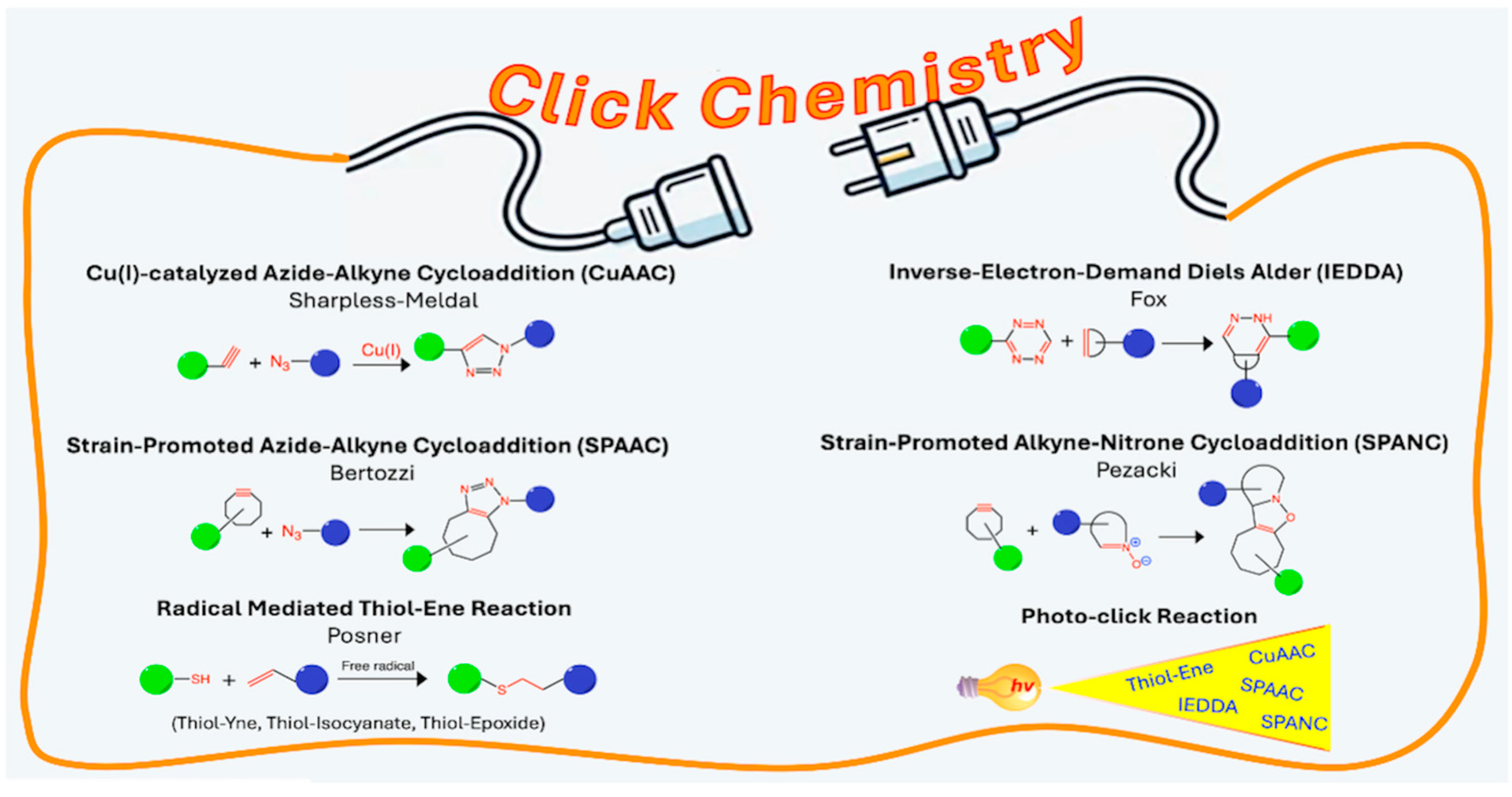
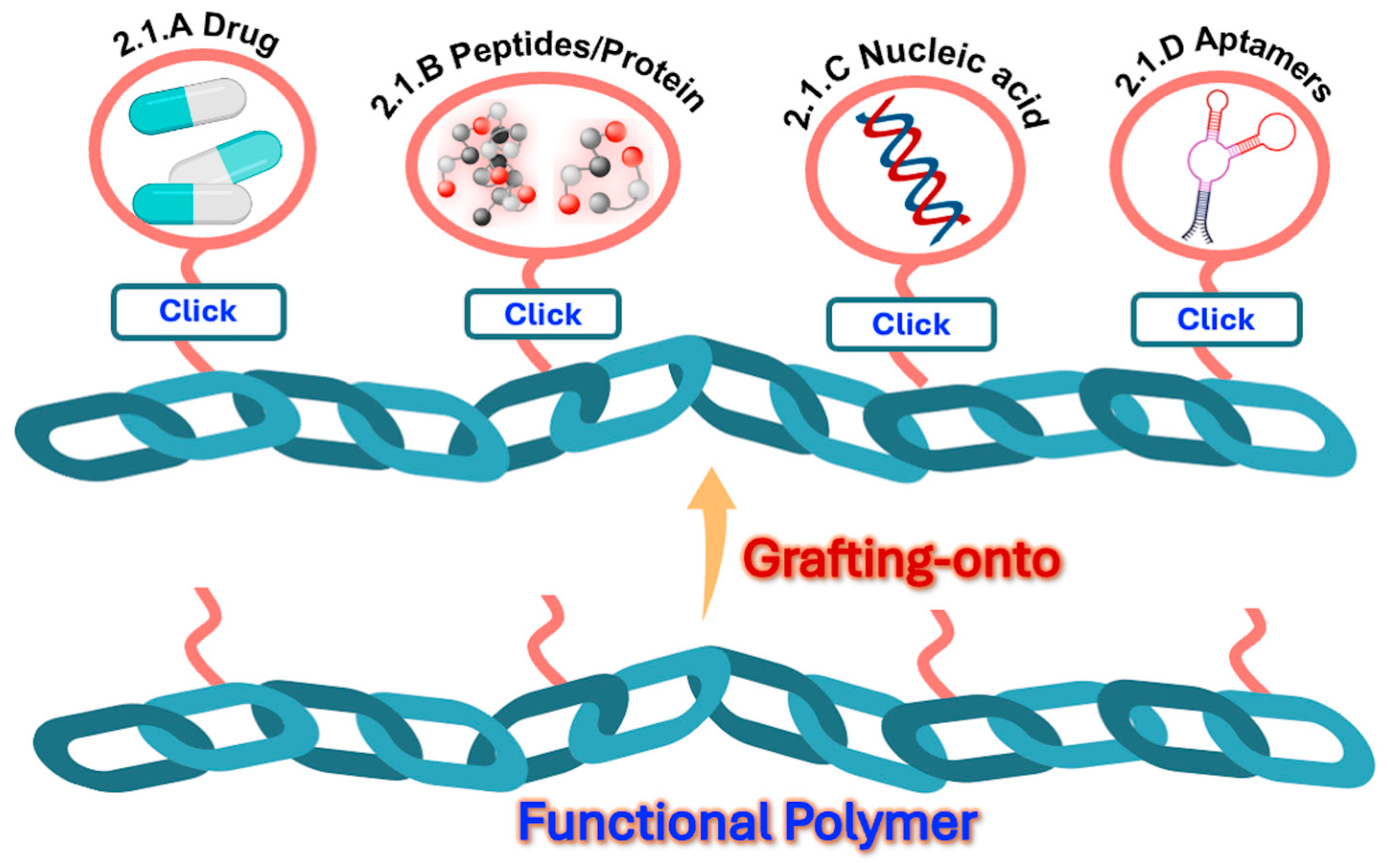
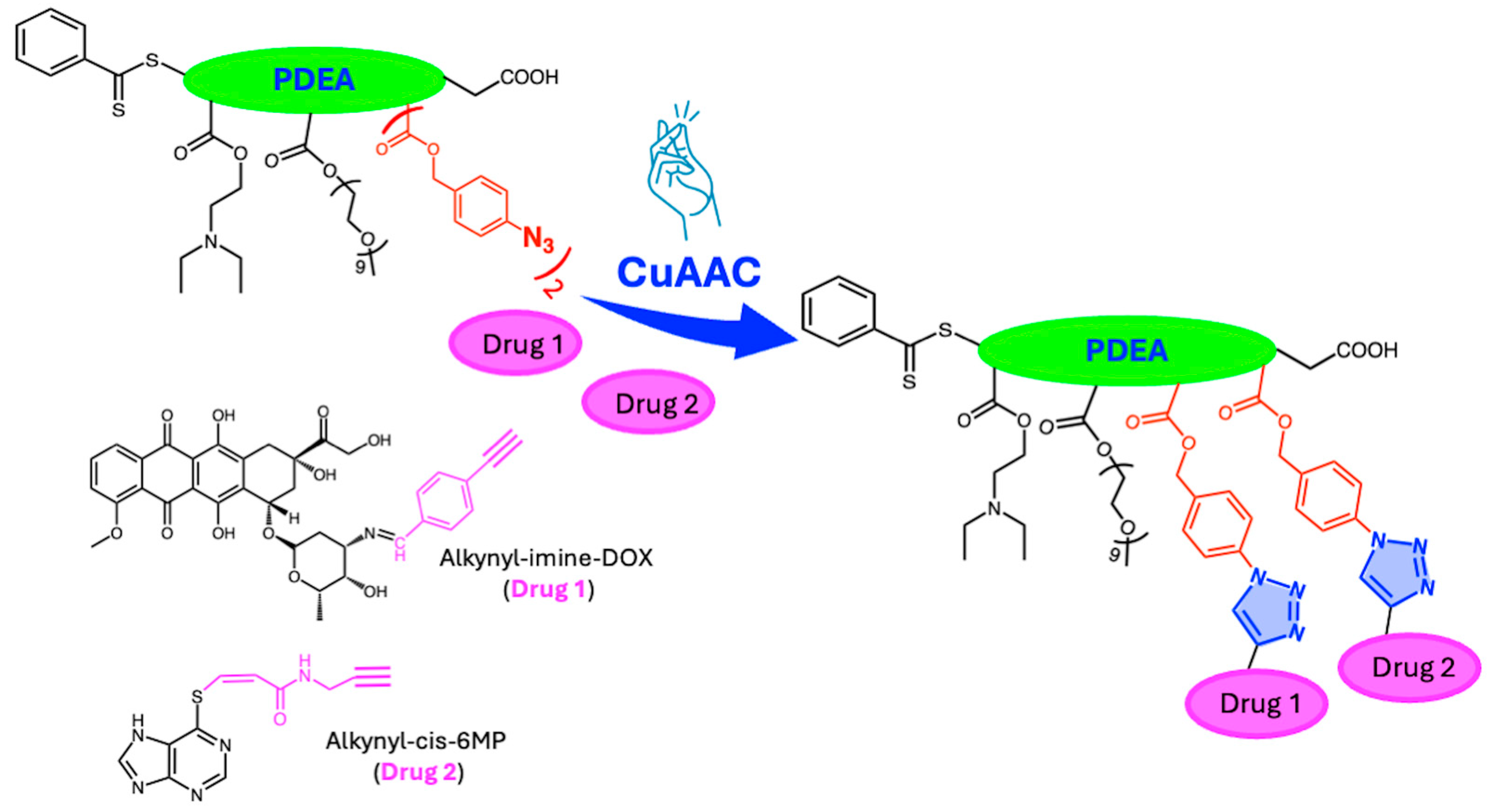
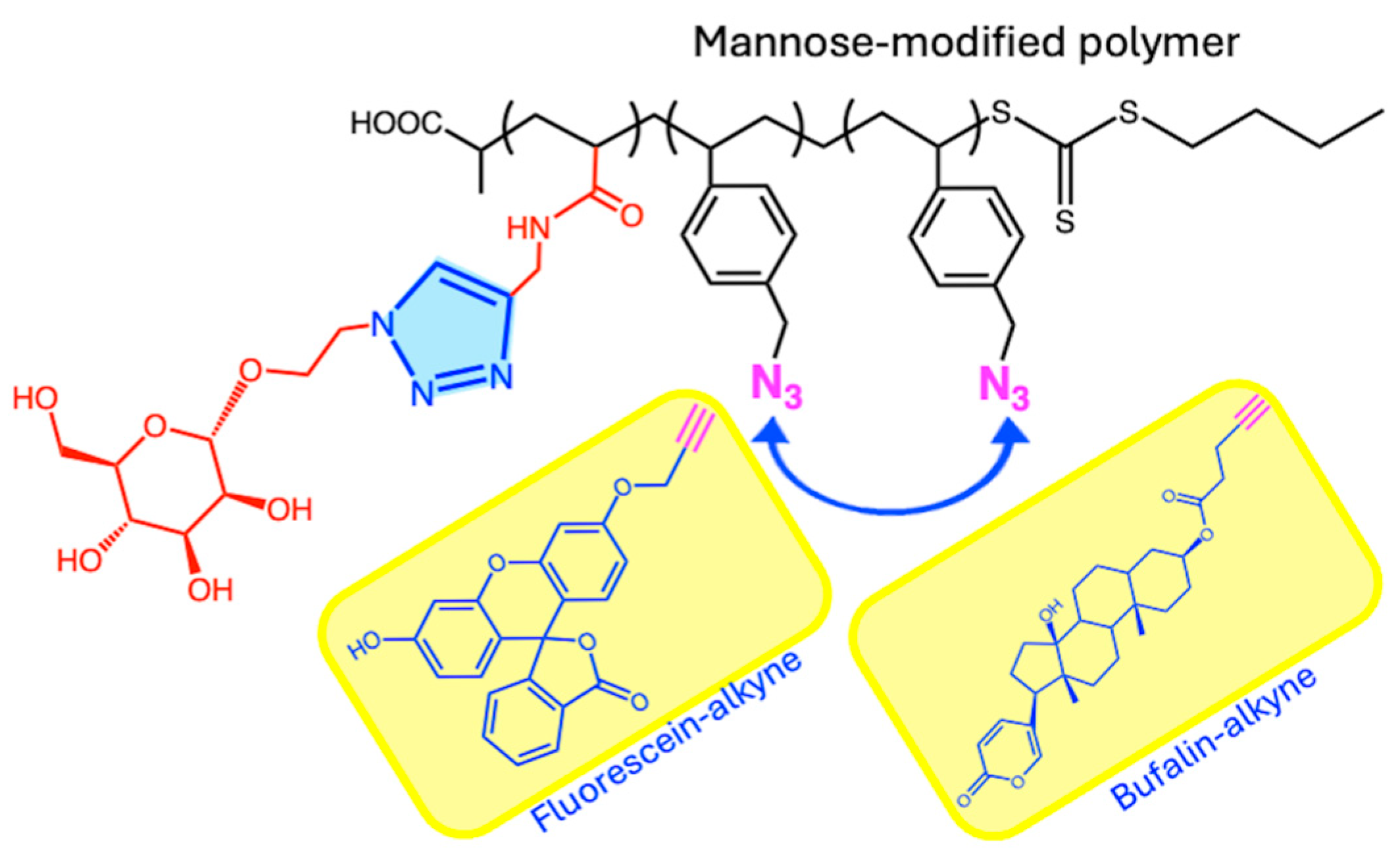
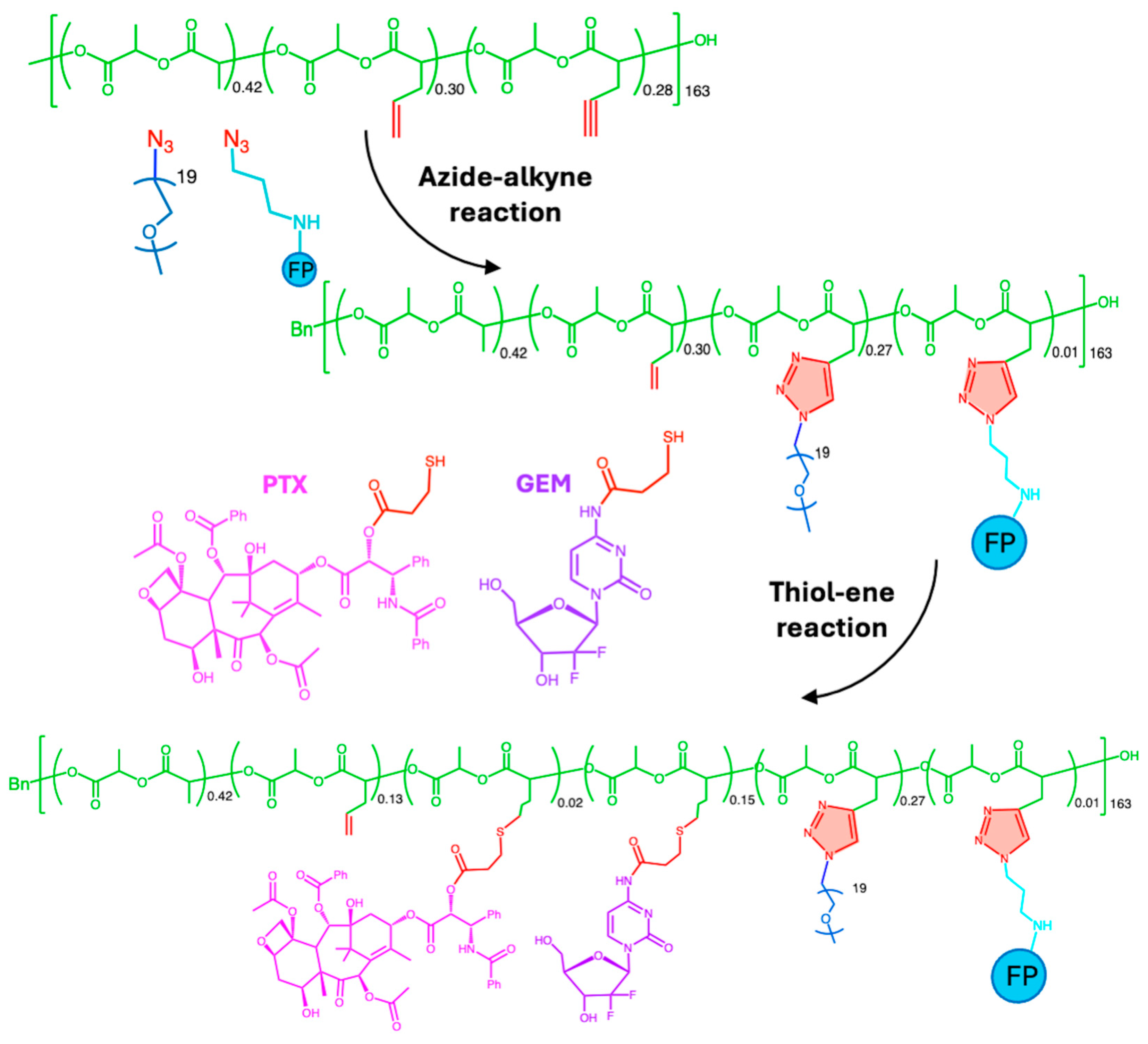
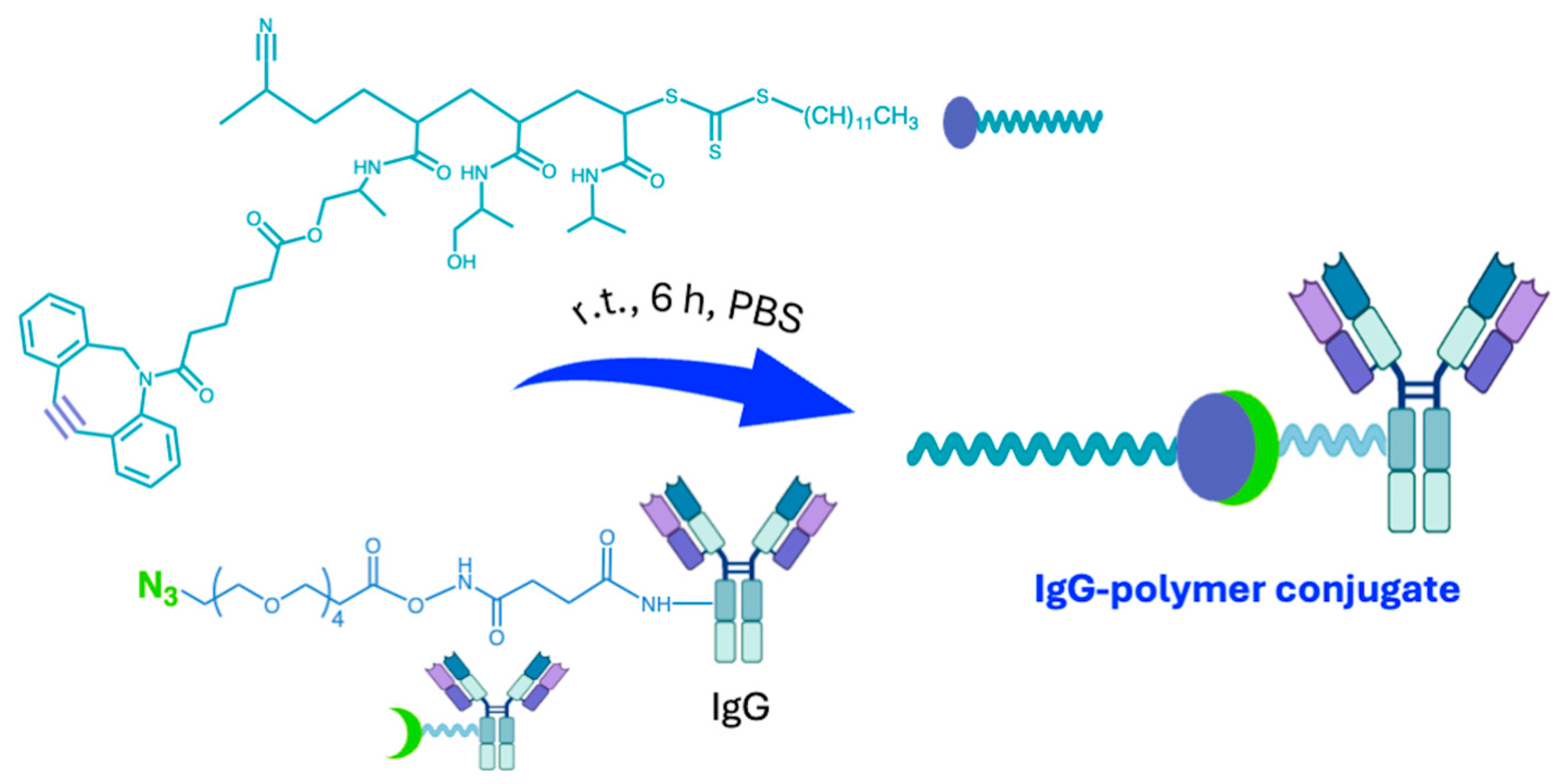

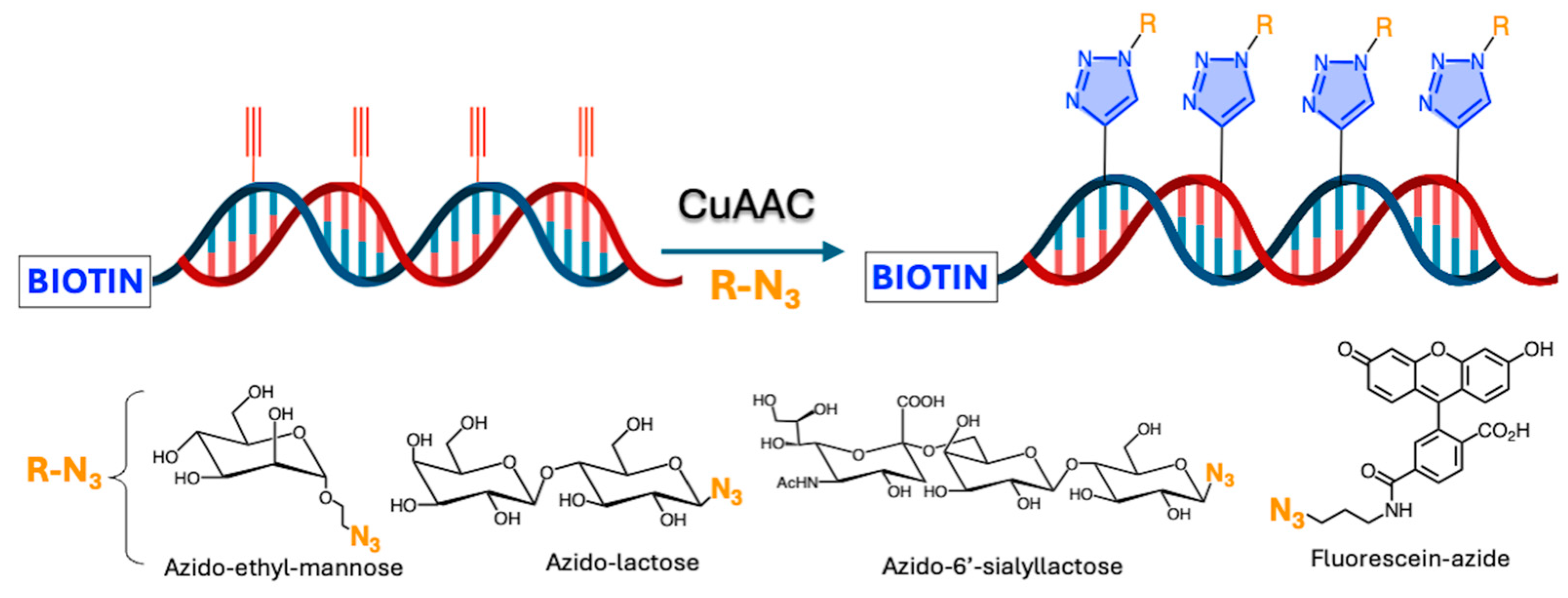

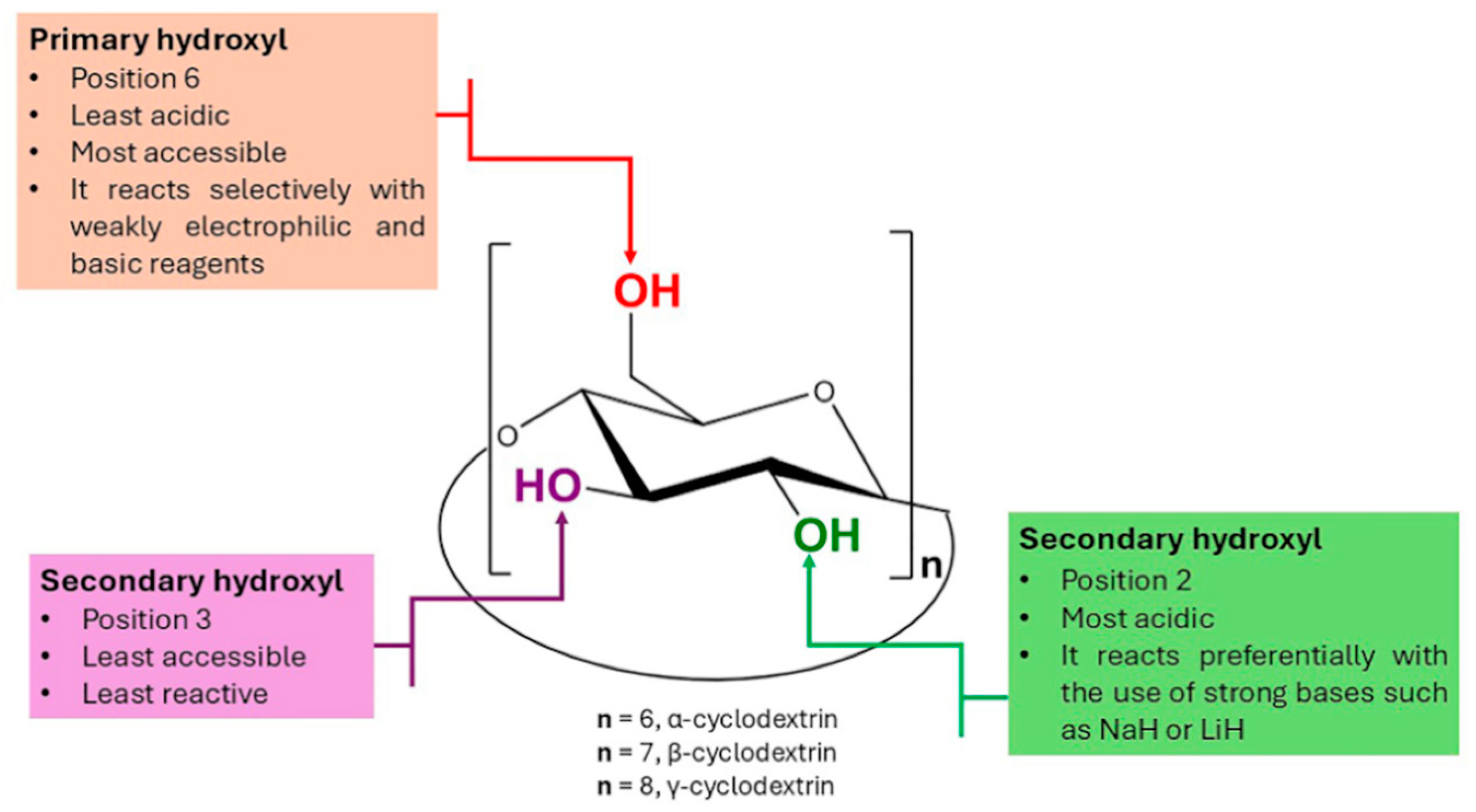
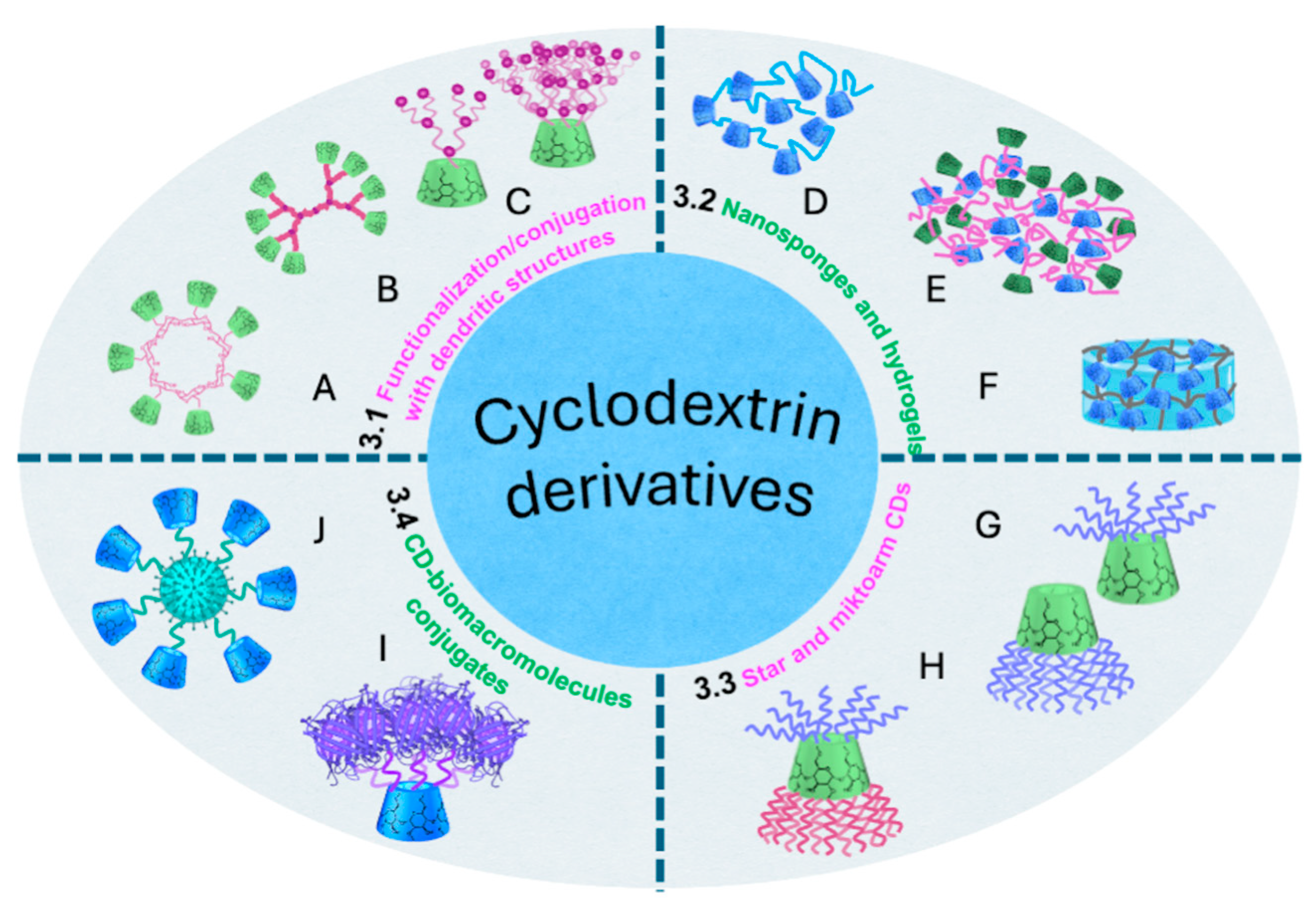
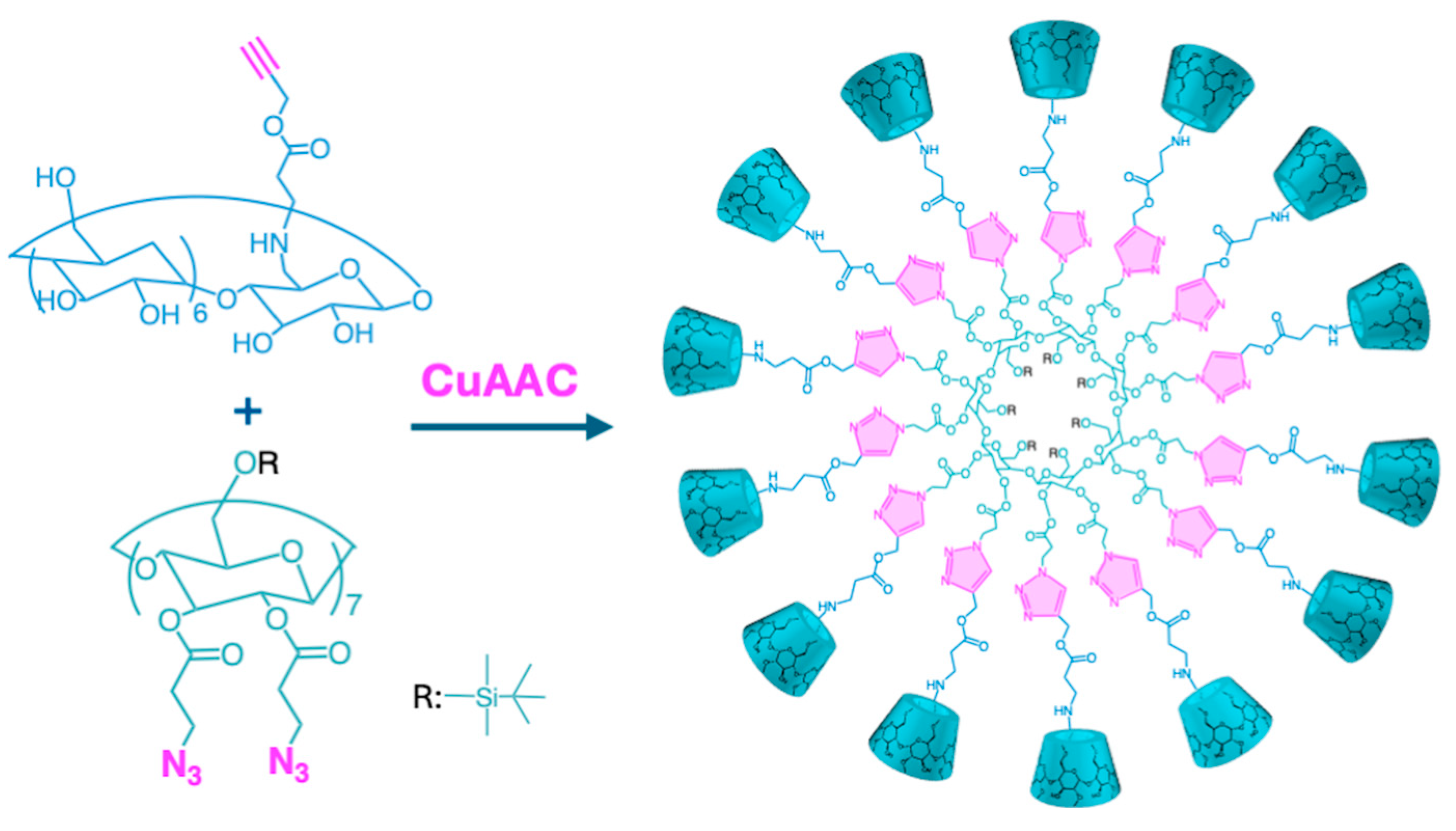
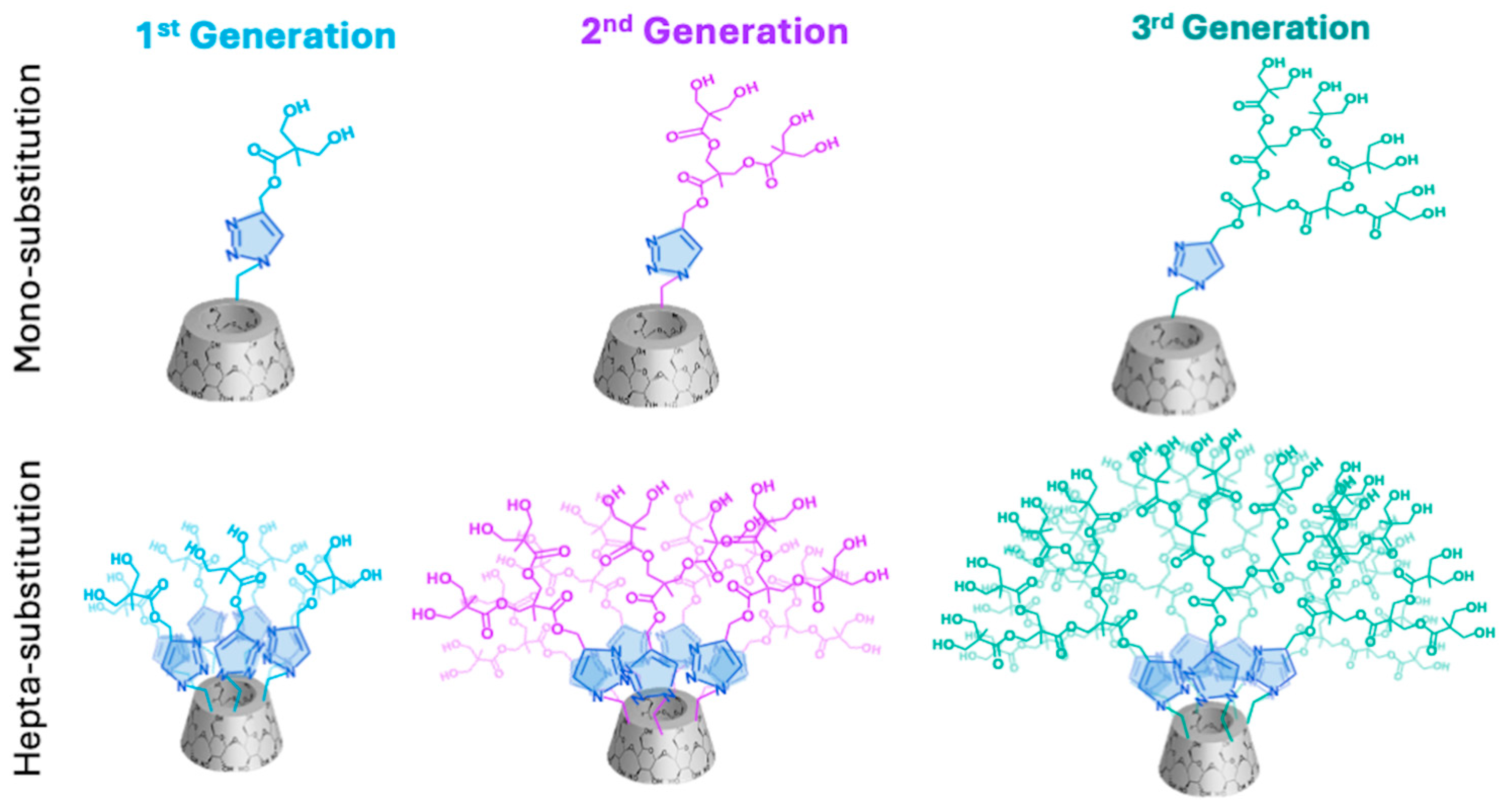

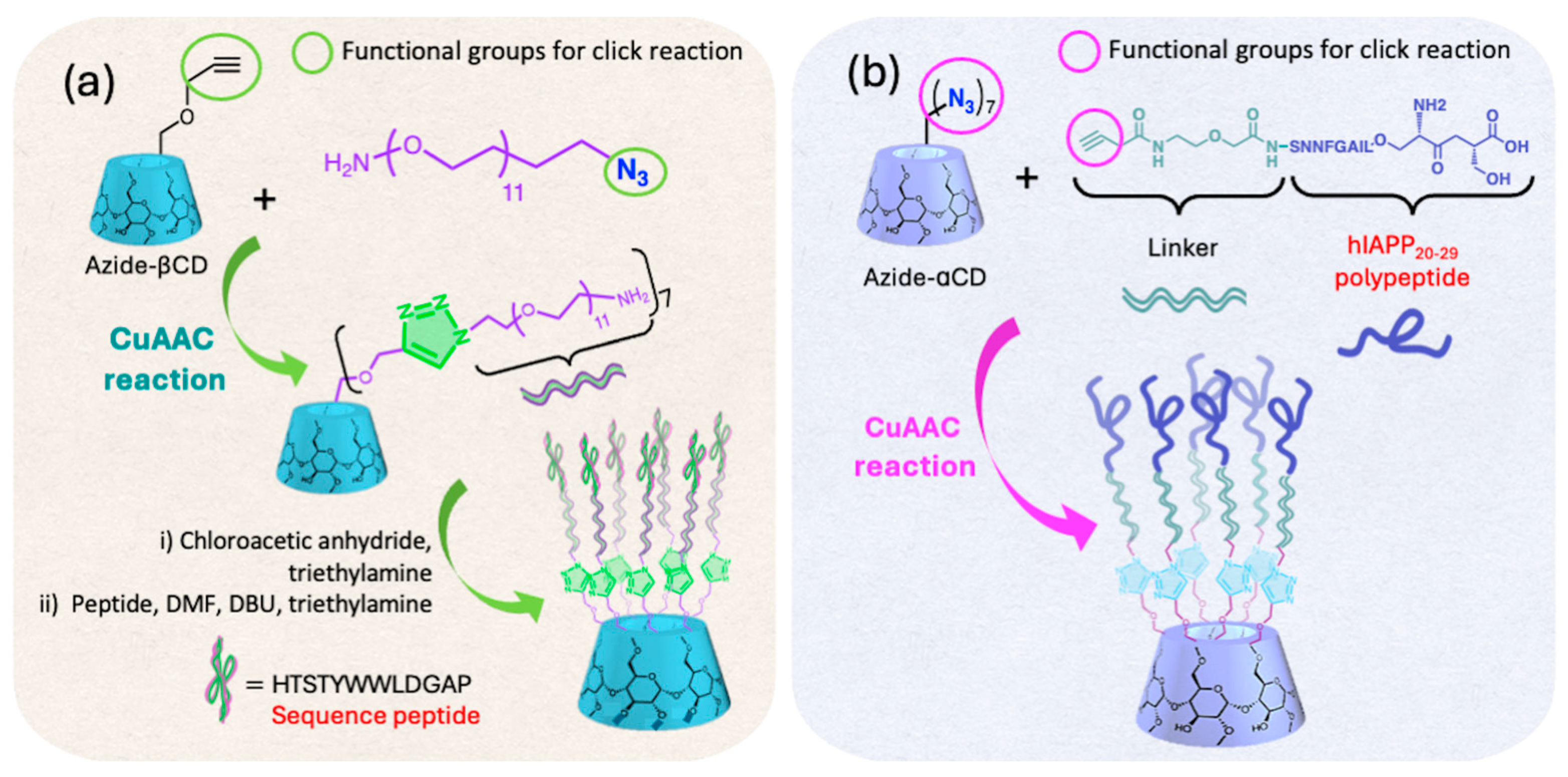
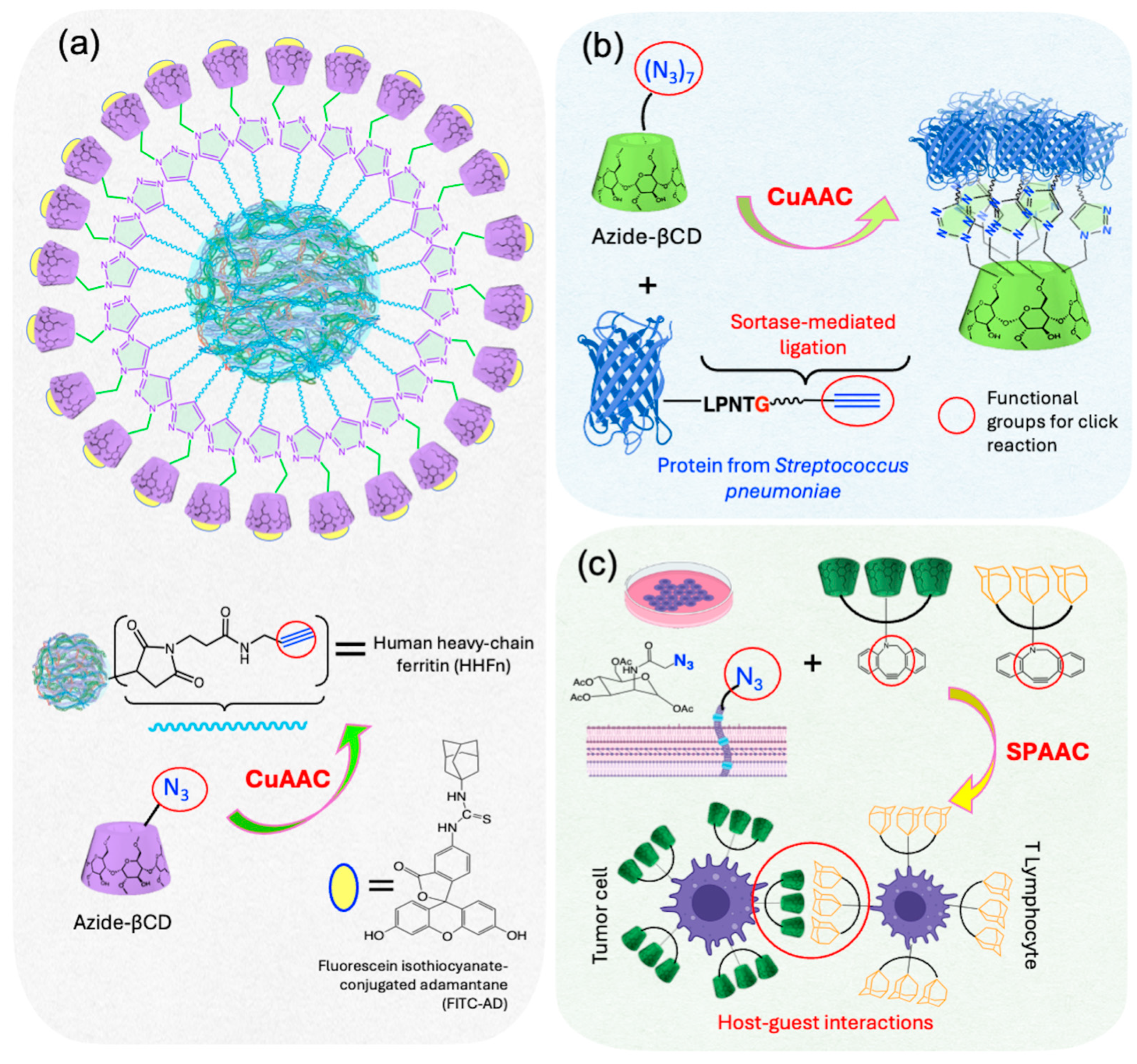

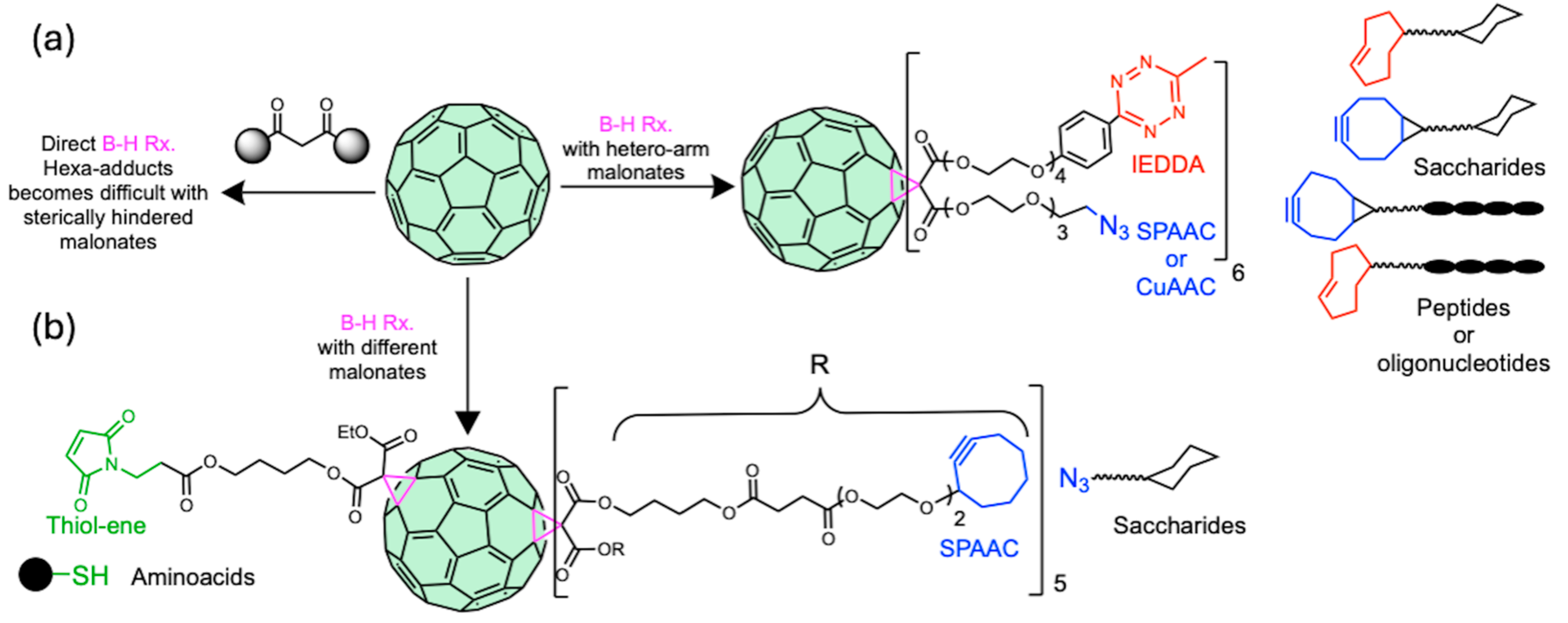
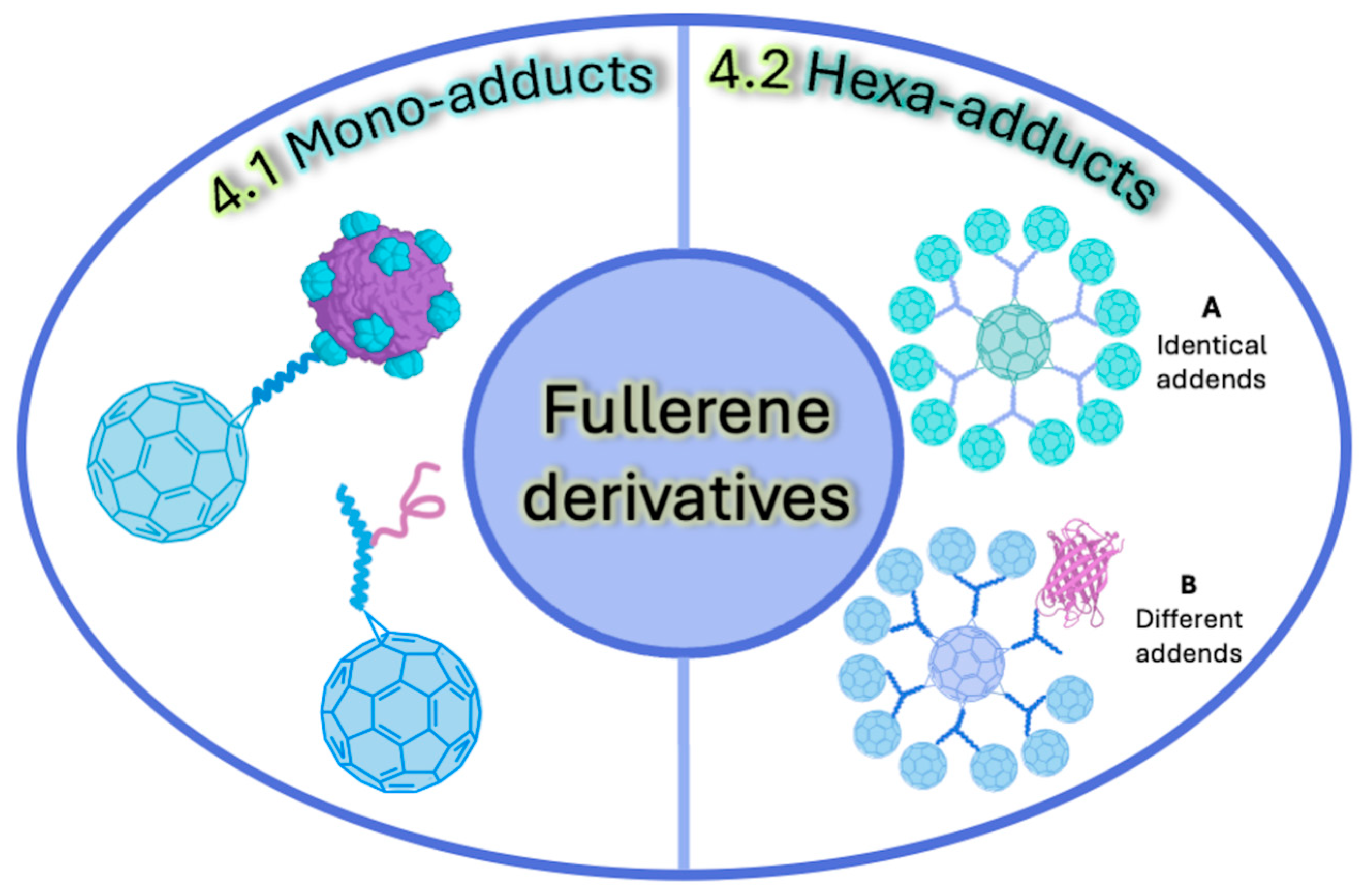

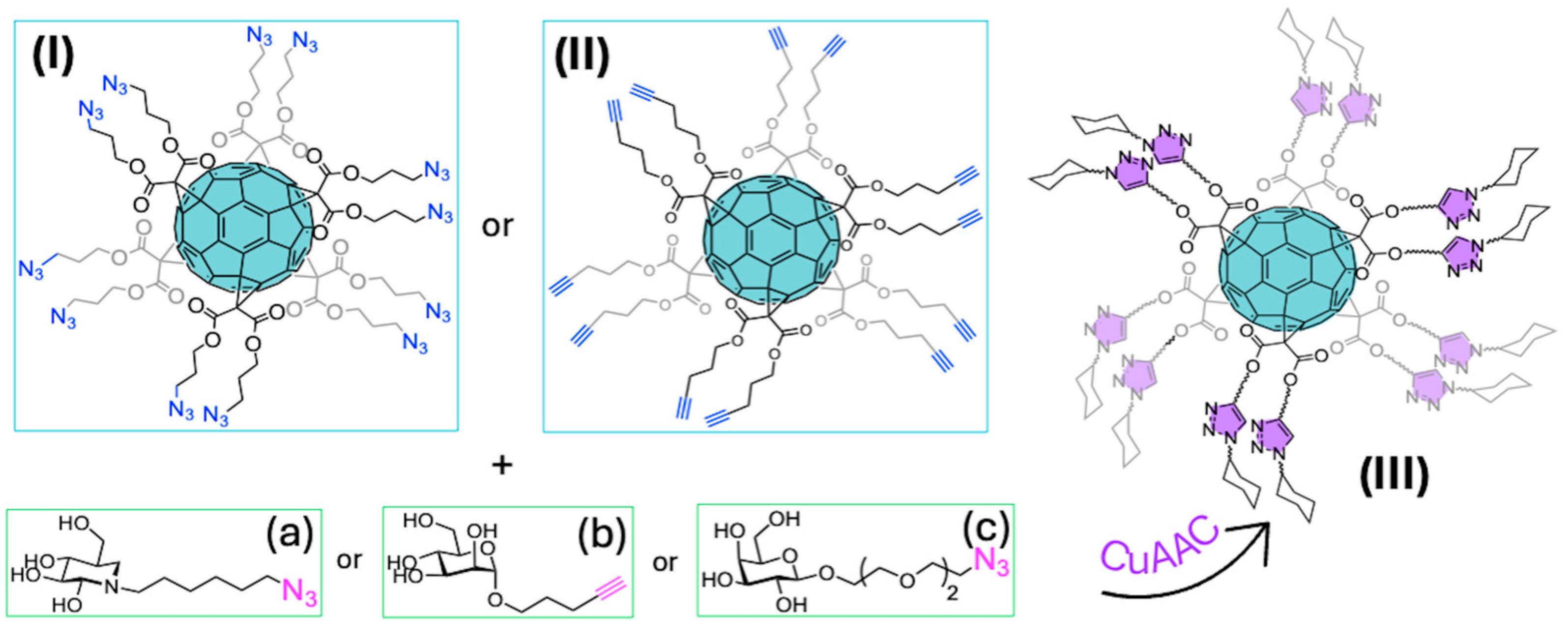
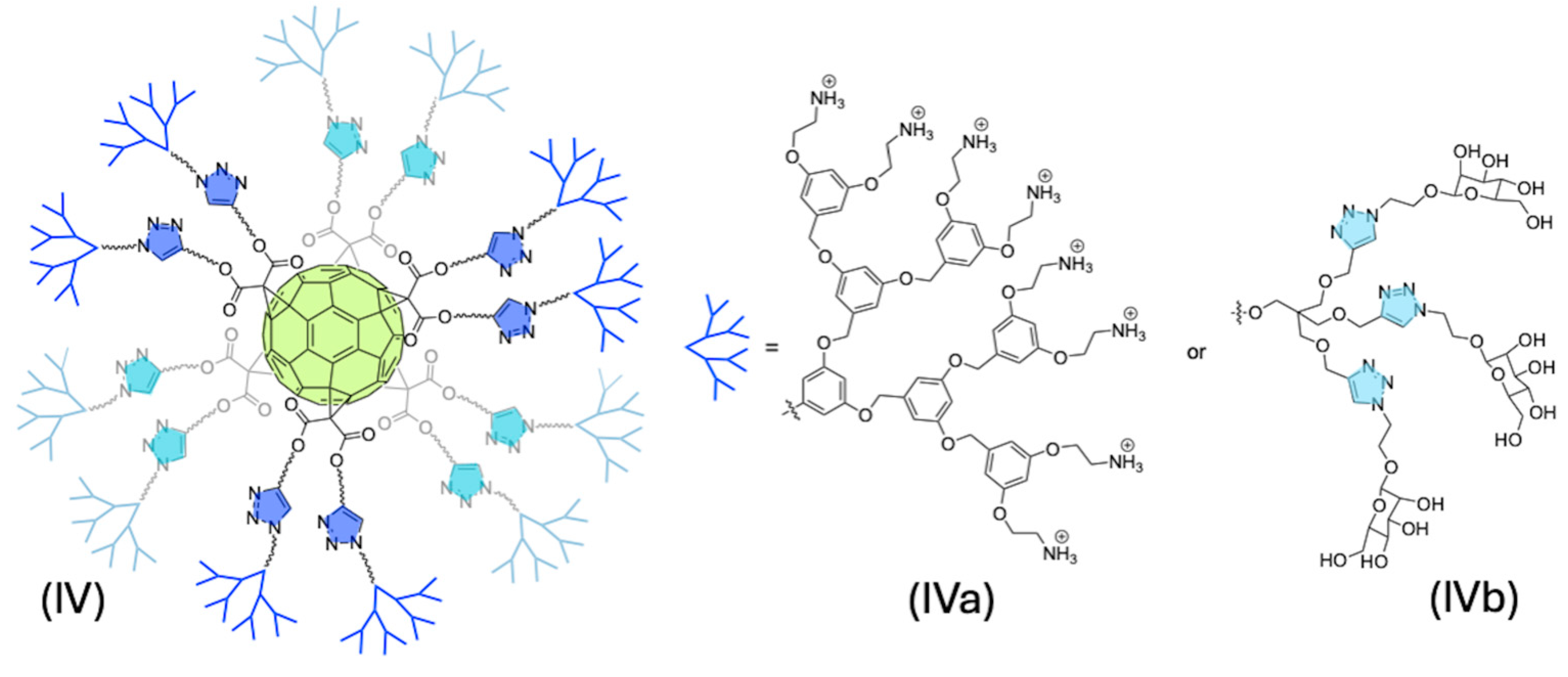
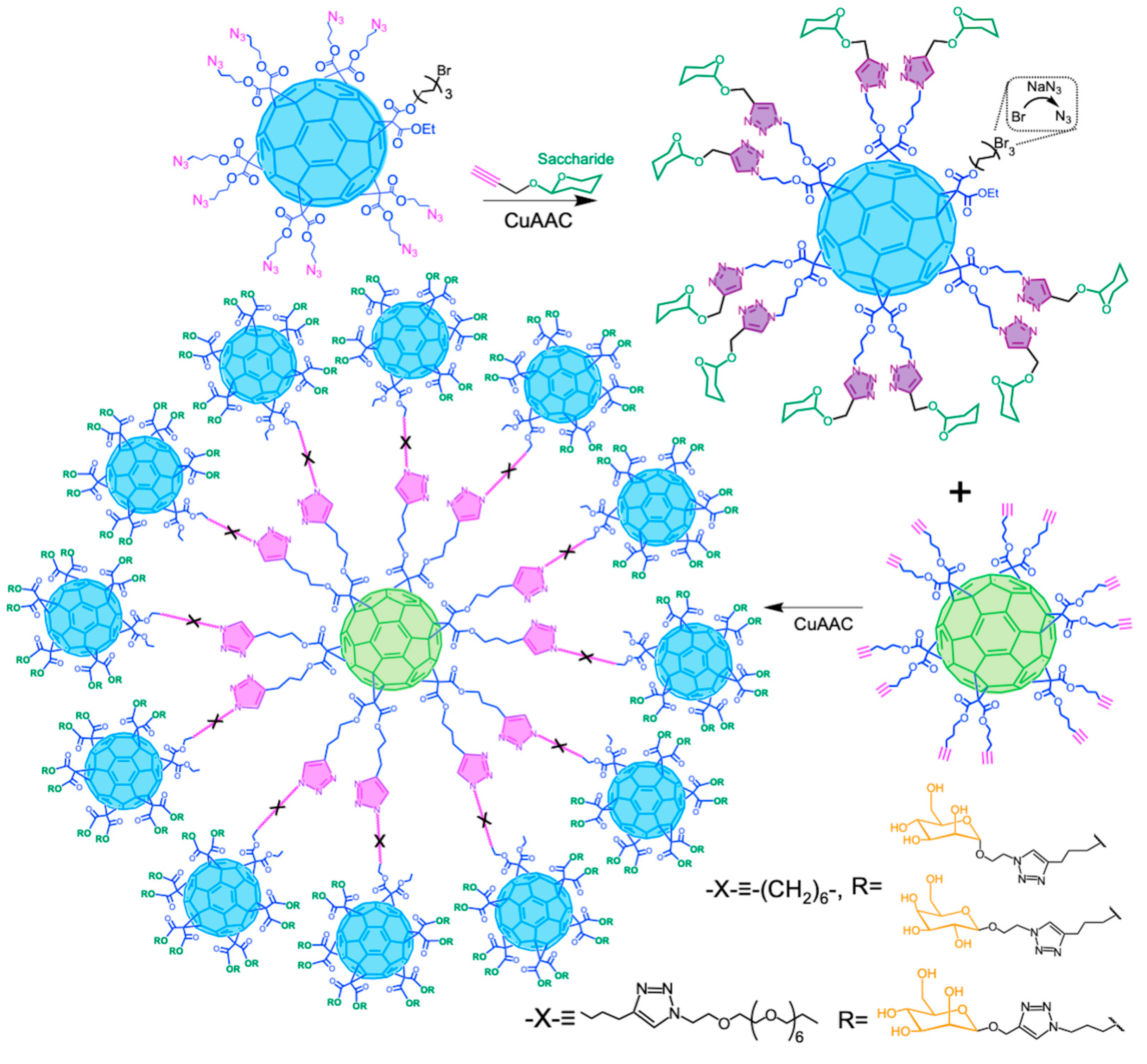
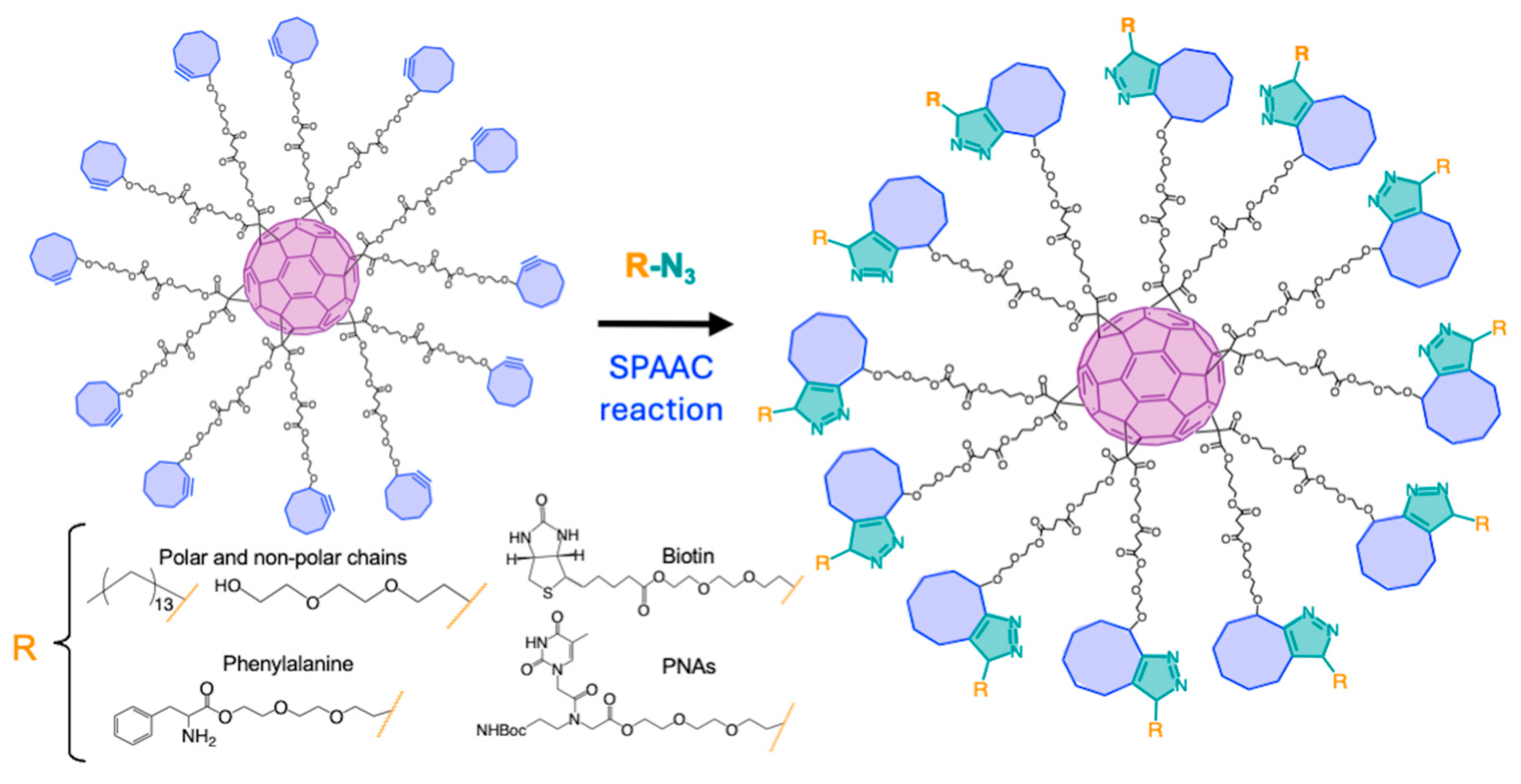
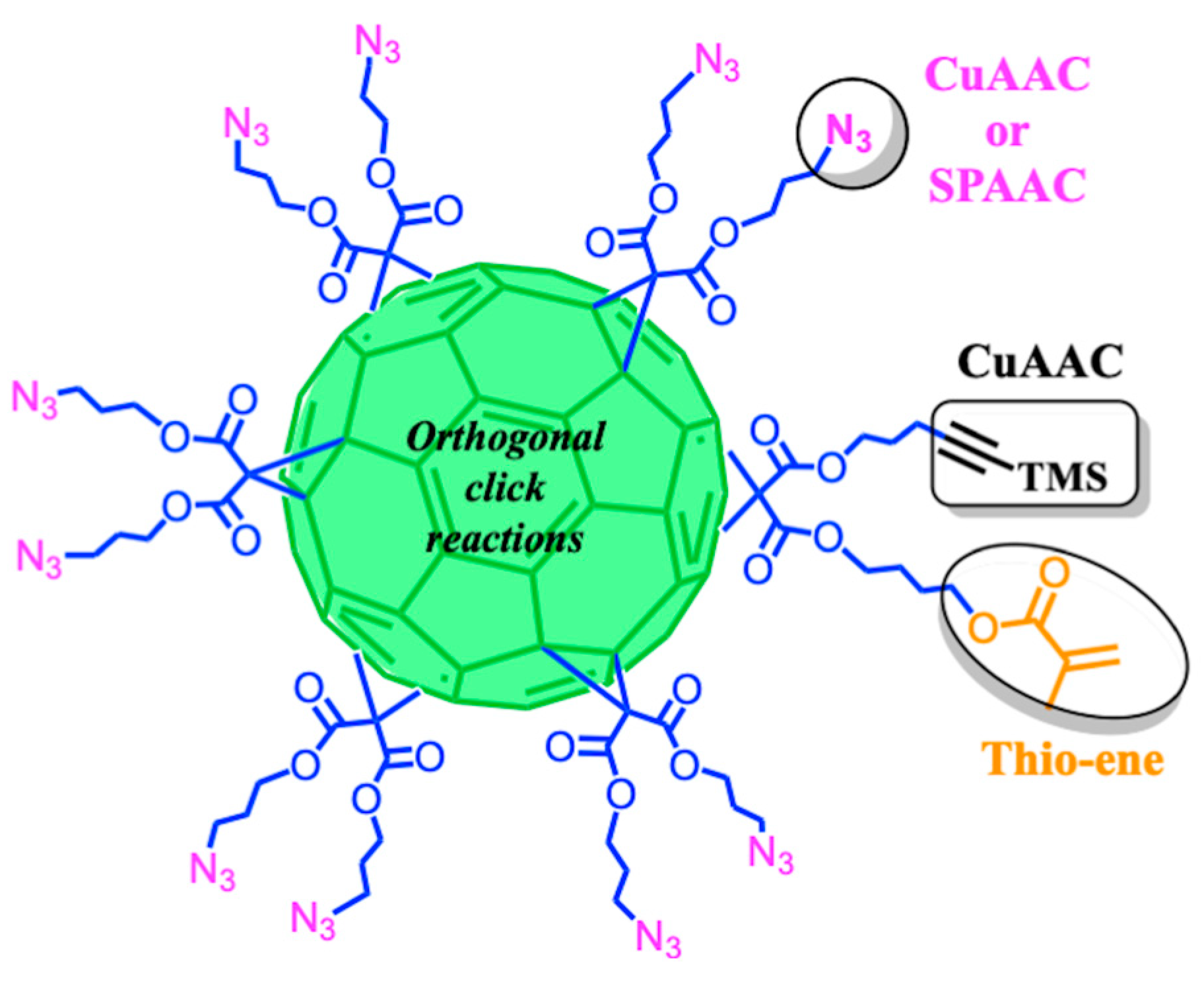


| Click Reaction | Application | System Type | Reference |
|---|---|---|---|
| CuAAC | Co-delivery system | 2.1 A | [37] |
| Controlled release system | 2.1 A | [38] | |
| Controlled release system and tumor-targeting | 2.1 A | [39] | |
| Targeted drug delivery | 2.1 A and 2.1 B | [40] | |
| Co-delivery system and tumor imaging agent | 2.1 A | [41] | |
| Antibody purification to diagnosis | 2.1 B | [42] | |
| Genetic polymer capable of post-functionalization | 2.1 C | [43] | |
| Drug and gene delivery | 2.1 C | [44] | |
| SPAAC | Drug delivery and diagnosis | 2.1 B | [45] |
| Biomarker to infectious diseases diagnostic | 2.1 B | [46] | |
| Drug delivery, molecular diagnostics, and gene regulation | 2.1 C | [47] | |
| Reversible anticoagulant activity | 2.1 D | [48] | |
| Detection of cell surface nucleolin | 2.1 D | [49] | |
| Targeted cancer therapy | 2.1 D | [50] | |
| Thiol–ene | Tissue remodeling | 2.1 B | [51] |
| 3D bioprinting | 2.1 B | [52] |
| Click Reaction | Application | System Type | Reference |
| CuAAC | Controlled drug delivery system | 3.1 A | [68] |
| Controlled drug delivery system | 3.1 A | [69] | |
| Antibody detection, serum analysis, and diagnosis | 3.1 C | [70] | |
| Drug delivery system | 3.1 B | [71] | |
| Drug delivery system | 3.1 C | [72] | |
| Drug delivery system | 3.2 D | [73] | |
| Controlled drug delivery system | 3.2 F | [74] | |
| Controlled drug delivery systems | 3.3 H | [75] | |
| Drug delivery system | 3.3 H | [76] | |
| MRI Contrast agent | 3.3 H | [77] | |
| Drug delivery system | 3.3 G | [78] | |
| Antibiotic therapy | 3.3 G | [79] | |
| Development of therapies for amyloid-related diseases | 3.3 G | [80] | |
| Drug delivery and diagnostics | 3.4 J | [81] | |
| Controlled drug delivery system | 3.4 I | [82] | |
| SPAAC | Cell-based therapies | 3.4 J | [83] |
| Thiol–ene | Tissue engineering | 3.2 E | [84] |
| Controlled drug delivery system | 3.2 E | [85] | |
| Implants or controlled drug delivery systems | 3.2 F | [86] | |
| Controlled drug delivery system | 3.3 H | [87] | |
| Diels–Alder | Controlled drug delivery system | 3.2 F | [88] |
| Click Reaction | Application | System Type | Reference |
| CuAAC | Tumor therapies and delivery system | 4.1 | [133] |
| Bacterial infection inhibitor | 4.2A | [134] | |
| Bacterial infection inhibitor | 4.2A | [135] | |
| Antiviral agent against HIV and EV71 | 4.2 A | [136] | |
| Antiviral agent against EBOV-GP | 4.2 A | [137] | |
| Antiviral agent against EBOV-GP | 4.2A | [138] | |
| Antiviral agent against EBOV-GP | 4.2A | [139] | |
| Solubility enhancement | 4.2 A | [140] | |
| Enzyme inhibition | 4.2 A and 4.2 B | [141] | |
| Enhancement cell penetration | 4.2 B | [142] | |
| SPAAC | Bioconjugation | 4.2 A | [143] |
| Antiviral agent against Zika virus | 4.2A | [144] | |
| Bioconjugation | 4.2B | [145] | |
| Thiol–ene | Bioconjugation | 4.2B | [145] |
Disclaimer/Publisher’s Note: The statements, opinions and data contained in all publications are solely those of the individual author(s) and contributor(s) and not of MDPI and/or the editor(s). MDPI and/or the editor(s) disclaim responsibility for any injury to people or property resulting from any ideas, methods, instructions or products referred to in the content. |
© 2024 by the authors. Licensee MDPI, Basel, Switzerland. This article is an open access article distributed under the terms and conditions of the Creative Commons Attribution (CC BY) license (https://creativecommons.org/licenses/by/4.0/).
Share and Cite
Cabrera-Quiñones, N.C.; López-Méndez, L.J.; Cruz-Hernández, C.; Guadarrama, P. Click Chemistry as an Efficient Toolbox for Coupling Sterically Hindered Molecular Systems to Obtain Advanced Materials for Nanomedicine. Int. J. Mol. Sci. 2025, 26, 36. https://doi.org/10.3390/ijms26010036
Cabrera-Quiñones NC, López-Méndez LJ, Cruz-Hernández C, Guadarrama P. Click Chemistry as an Efficient Toolbox for Coupling Sterically Hindered Molecular Systems to Obtain Advanced Materials for Nanomedicine. International Journal of Molecular Sciences. 2025; 26(1):36. https://doi.org/10.3390/ijms26010036
Chicago/Turabian StyleCabrera-Quiñones, Neyra Citlali, Luis José López-Méndez, Carlos Cruz-Hernández, and Patricia Guadarrama. 2025. "Click Chemistry as an Efficient Toolbox for Coupling Sterically Hindered Molecular Systems to Obtain Advanced Materials for Nanomedicine" International Journal of Molecular Sciences 26, no. 1: 36. https://doi.org/10.3390/ijms26010036
APA StyleCabrera-Quiñones, N. C., López-Méndez, L. J., Cruz-Hernández, C., & Guadarrama, P. (2025). Click Chemistry as an Efficient Toolbox for Coupling Sterically Hindered Molecular Systems to Obtain Advanced Materials for Nanomedicine. International Journal of Molecular Sciences, 26(1), 36. https://doi.org/10.3390/ijms26010036







